- 86-19138970032 (GMT+8 18:00~09:00)

- Beijing Xian Tours
- Shanghai Beijing Tours
- Hong Kong Guilin Tours
- Hangzhou Suzhou Tours
- Kunming Lijiang Tours
- Shanghai Yangtze Cruise Tours
- Chengdu Tibet Tours
- More Short Stay Tours
- China Tours in January
- China Tours in February
- China Tours in March
- China Tours in April
- China Tours in May
- China Tours in June
- China Tours in July
- China Tours in August
- China Tours in September
- China Tours in October
- China Tours in November
- China Tours in December

- High Speed Trains
- China Yangtze Cruise Tour
- Photography
- Desert Adventure
- Ethnic Villages
- Biking Tours
- Kung Fu Tours
- Heritage Sites Exploration
- China Spring Tours
- China Summer Tours
- China Autumn Tours
- China Winter Tours
Notice! 2024 available cruise routes include 4~5 days Chongqing-Yichang(most classic) and 11~12 days Chongqing-Yichang-Shanghai(limited).

- Best-value Yangtze Cruises
- Top Family-friendly Cruise Ships
- Top 3 Luxury Yangtze River Cruises
- Yangtze River Highlights
- Yangtze River Cruise Routes
- Upstream or Downstream?
- Dining & Drinking
- Accommodations
- On-board Activities
- Yangtze Cruise Booking Steps

- Inner Mongolia

- Fanjingshan
- How to Plan Your First China Tour
- How to Plan Beijing Tour
- How to Plan Xian Tour
- How to Plan Shanghai Tour
- How to Plan Guilin Tour
- How to Plan Sichuan Tour
- How to Plan Family Tour
- 2024 China Travel Ideas
- Best Time to Visit China
- What to Pack for Your China Journey
- Make Payment in China & Currency Exchange
- Updated China Travel News
- Ultimate Chinese Visa Guide
- Chinese Visa Types
- Chinese Visa Requirements
- Do I Need a Visa for China
- Chinese Visa Application
- Chinese Visa Exemptions
- 144-hour Visa Free
- Shenzhen Visa on Arrival
- Hainan 30-day Visa Free
- Embassies & Consulates
- Invitation Letter
- Useful Visa FAQs & Tips
- Entry Regulations
- Baggage Allowance
- Customs Declaration
- Exit Regulation
- How to Book Train Tickets
- How to Collect Train Tickets
- How to Cancel & Alter Train Tickets
- How to Read Train Tickets
- China High Speed Train Types
- Seats Class & How to Choose
- Friendly Facilities on the Train
- The Train Station Departure Process
- Available Food and Drinks on the Train
- Western Toilets on the Train
- Luggage Racks & Baggage Allowance
- Beijing Train Stations
- Shanghai Train Stations
- Guilin Train Stations
- Xian Train Stations
- Chengdu Train Stations
- Hong Kong West Kowloon Railway Station
- Beijing - Xian
- Beijing - Shanghai
- Guangzhou - Shanghai
- Shenzhen - Shanghai
- Chengdu - Xian
- Shanghai - Hangzhou
- Shanghai - Xian
- Chengdu - Chongqing
- Kunming - Lijiang
- Beijing Capital International
- Beijing Daxing International
- Shanghai Pudong International
- Shanghai Hongqiao International
- Guangzhou Baiyun International
- Hangzhou Xiaoshan International
- Chengdu Tianfu International
- Chengdu Shuangliu International
- Xian Xianyang International
- Shanghai - Beijing
- Hong Kong - Shanghai
- Guangzhou - Beijing
- Chengdu - Lhasa
- Shanghai - Guilin
- Shanghai - Sanya
- Travel in Spring Season
- Travel in Summer Season
- Travel in Autumn Season
- Travel in Winter Season
- Weather in January
- Weather in February
- Weather in March
- Weather in April
- Weather in May
- Weather in June
- Weather in July
- Weather in August
- Weather in September
- Weather in October
- Weather in November
- Weather in December
- Top 10 China Destinations
- Top 15 Things to Do
- China World Heritage Sites
- Top 10 Best Natural Beauties
- Top 10 Museums in China
- Top 10 Old Towns & Villages
- Five Great Mountains in China
- Top 10 Monasteries & Temples
- Top 10 Ski Resorts
- Top 10 Beautiful Lakes in China
- 7 Best Beaches in Sanya
- Top 6 Beautiful Waterfalls
- Panda Volunteering
- Having fun on Ice and Snow Festival
- About Us Who We Are Our Team Why Travel with Us Feedback & Reviews Travel Stories Travelers' Gallery Payment Guide Customer Support Contact Us
- Tour Experiences

Destinations
- Travel Guide
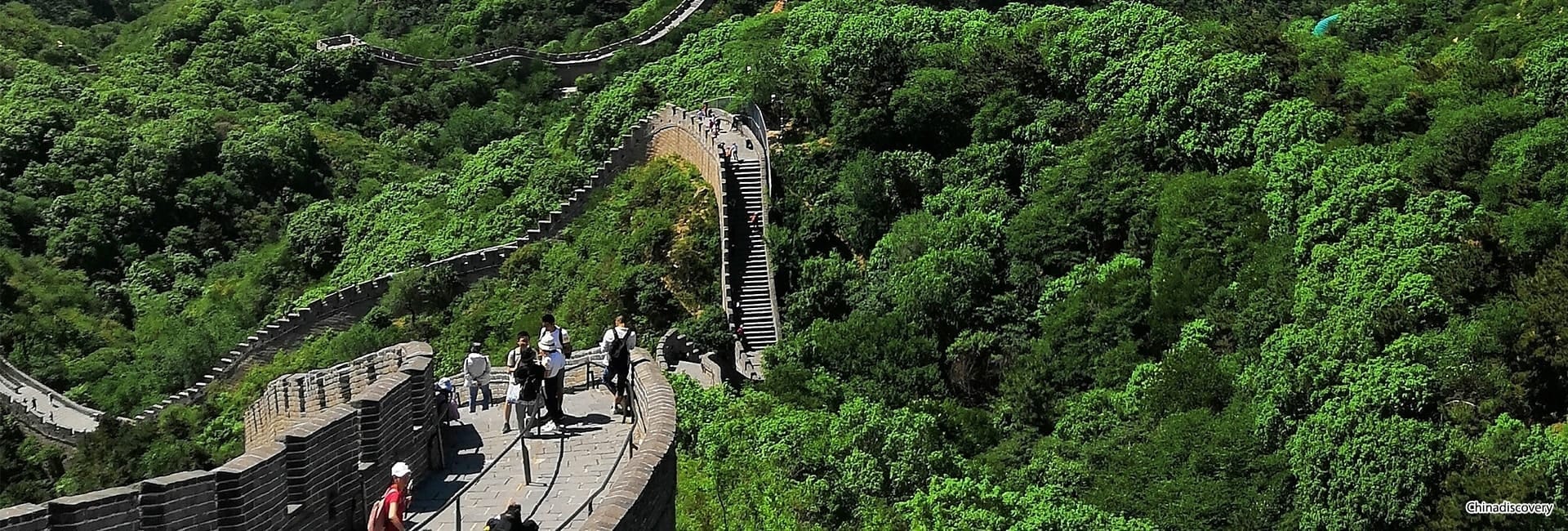
Great Wall Tourism Board | Updated Great Wall of China Travel Information
“He who has not climbed the Great Wall is not a true man!”, as what was said by China’s first Chairman Mao Zedong, the Great Wall should be on every traveler’s bucket list. This China’s greatest engineering triumph, made from brick, stone, tamped earth and wood, is a direct link with legendary dynasties of China’s past as there were continuous ancient dynasties invested unquantifiable labour and material resources to construct and reconstruct the Great Wall. Nowadays, you can still see there are more than 5,500 miles of the Great Wall snaking its way over the perched mountainsides from the gobi desert in northwestern China to the sea coast of far eastern China. Beijing, the capital city, possesses about 573km (356 miles) of the Great Wall including the world famous Badaling, Mutianyu, Jiankou, etc., stretching alone the steep peaks and hills at its remote northern districts. You can easily plan a satisfied day trip to the closer sections of the Great Wall from Beijing. But for those who want to explore, it’s available to hike, bike even camp on some sections. Contact China Discovery to tailor-make a Great Wall trip now!
Latest Notice on Great Wall Travel - Updated on May 25, 2023 :
The Beijing Great Wall Protection and Management Regulations clearly state that it is prohibited to organize tours or climb sections of the Great Wall that have not been approved for visitation. Violators may be subject to corresponding fines. The Jiankou Great Wall is an unopened section of the Great Wall, and climbing it can cause damage to the structure. This not only hinders the preservation of the Great Wall but also poses significant risks to the safety of visitors. Therefore, we urge everyone not to climb the Jiankou Great Wall. Tourists can visit and hike at well-developed sections of the Great Wall such as Mutianyu, Badaling, and Jinshanling instead.
- ① Where is the Great Wall of China Located?
- ② When was the Great Wall of China Built?
- ③ Who Built the Great Wall of China?
- ④ How Old is the Great Wall of China?
- ⑤ How Long is the Great Wall of China?
- ⑥ How Tall is the Great Wall of China?
- ⑦ How Big is the Great Wall of China?
- ⑧ How was the Great Wall of China Built?
- ⑨ Why was the Great Wall of China Built?
- ⑩ Can You See the Great Wall of China from Space?
Top 7 Most Popular Sections of Great Wall
Many people mistakenly assume that the Great Wall of China is a continuous entity. Actually, the Great Wall exists in chunks scattered with natural defenses, usually the precipitous mountains. According investigations, the Great Wall of China stretches through 16 provinces, cities and autonomous regions, such as Shandong, Henan, Hebei, Inner Mongolia, Shanxi, Shaanxi, Gansu, Liaoning, Ningxia, Beijing, Tianjin, Xinjiang, Heilongjiang, Qinghai, Jilin and Hubei, etc. Taking into location, landscape, transportation, tourist amenities into consideration, below 7 sections of Great Wall are most popular among tourists.

Which Section of Great Wall to Go
Generally speaking, Mutianyu is the best option if you travel with kids, or want to enjoy a leisure and scenic hike. If you are a hiker, choose 1 or 2 sections among Jinshanling, Simatai and Gubekou to hike 1 or 2 days. If you are the second-timer, maybe Huanghuacheng section will be very attractive to you. Its lakeside walls are very stunning. Read more about What Are the Best Sections of the Great Wall to Visit from Beijing?
Important Great Wall Travel Information & Tips
Below are the most important and useful articles with information and tips to help you plan your Great Wall trip easier. Fee free to contact us if you have any question about the Great Wall.
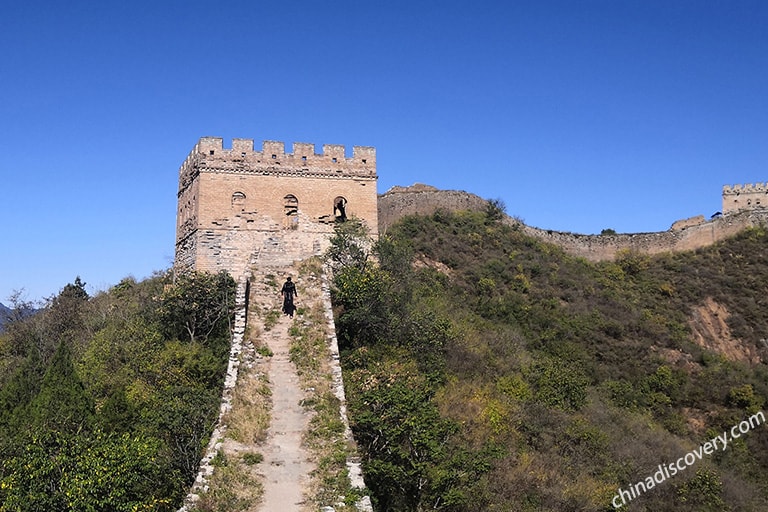
Great Wall Trip Planning
We have complied this Great Wall of China Ultimate Guide which have synthesized the most useful insights and tips from our Great Wall researcher and Beijing local tour guide to help you plan the perfect Great Wall adventure.
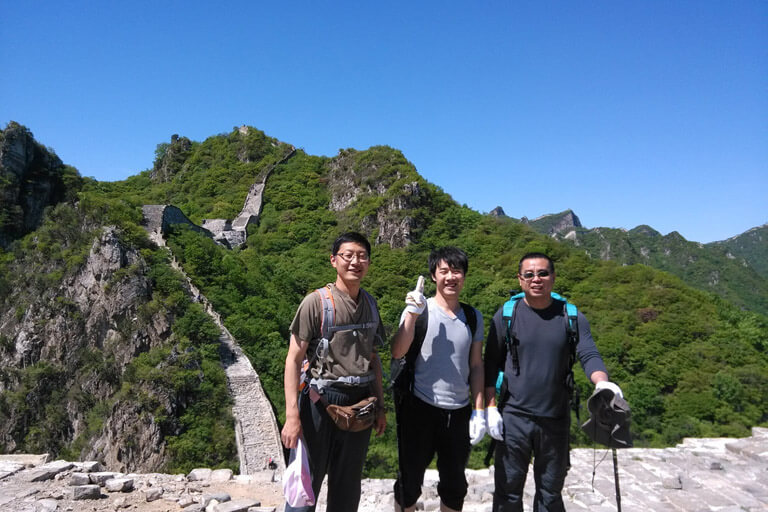
Great Wall Hiking
Our travel experts’ handpicked top Great Wall Hiking tour packages which take you to explore the best sections of Great Wall, such as Mutianyu, Huanghuacheng, Jiankou, Jinshanling, Simatai, etc.
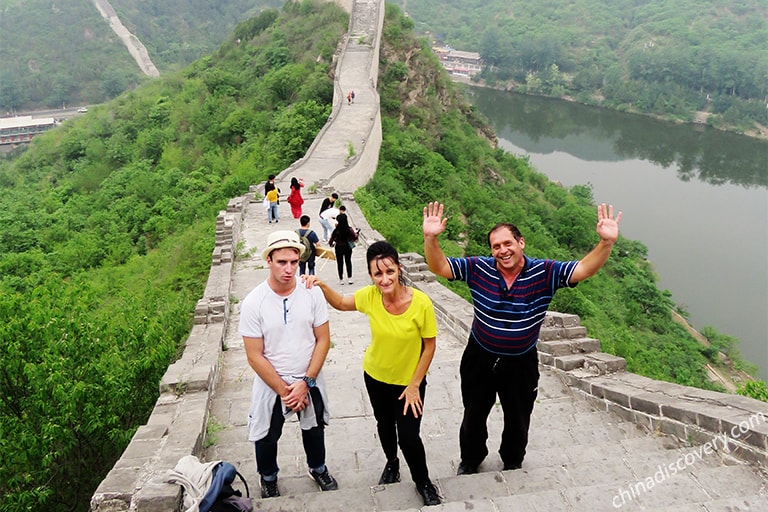
Best Time to Visit
The Great Wall is theoretically suitable to visit all year round. But considering most people would prefer a trip on beautiful days with fewer crowds, the best time is spring and autumn, especially in April, May, September, and November.
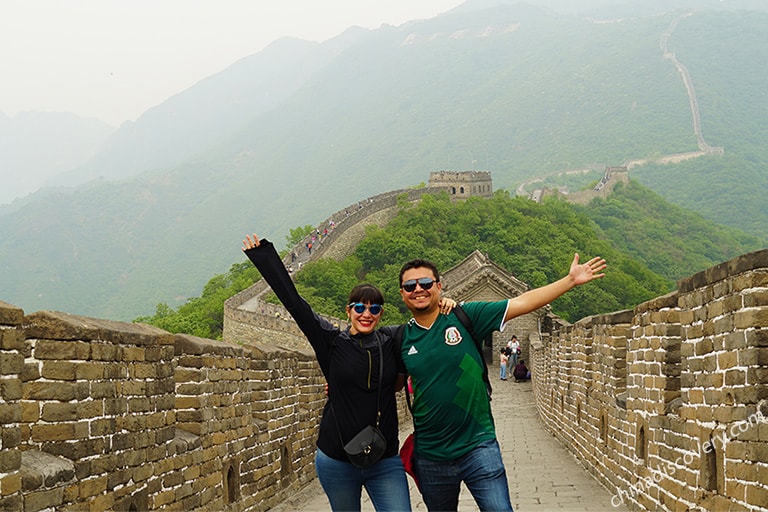
Great Wall Restaurants
There is no restaurant on the Great Wall, but some sections of Great Wall, such as Mutianyu, Jinshanling, Badaling, provide restaurants which are usually located at the feet of the Great Wall.
How to Get to & Around Great Wall of China
The location of each section of Great Wall varies greatly so is the available transportation. Some sections, which are closer to Beijing, can be reached easily, such as Badaling, Mutianyu, Juyongguan and Huanghuacheng. These sections of Great Wall provide flexible choices of transportation, including private car, train, tourist bus and public buses. Some sections of Great Wall are much further away from Chengdu, including Jinshanling, Simatai, Gubekou. Travellers can only get there by private car or public buses (usually takes much longer, and need to change bus for several times). To know more transportation information of Great Wall, please check how to get to & around Great Wall !
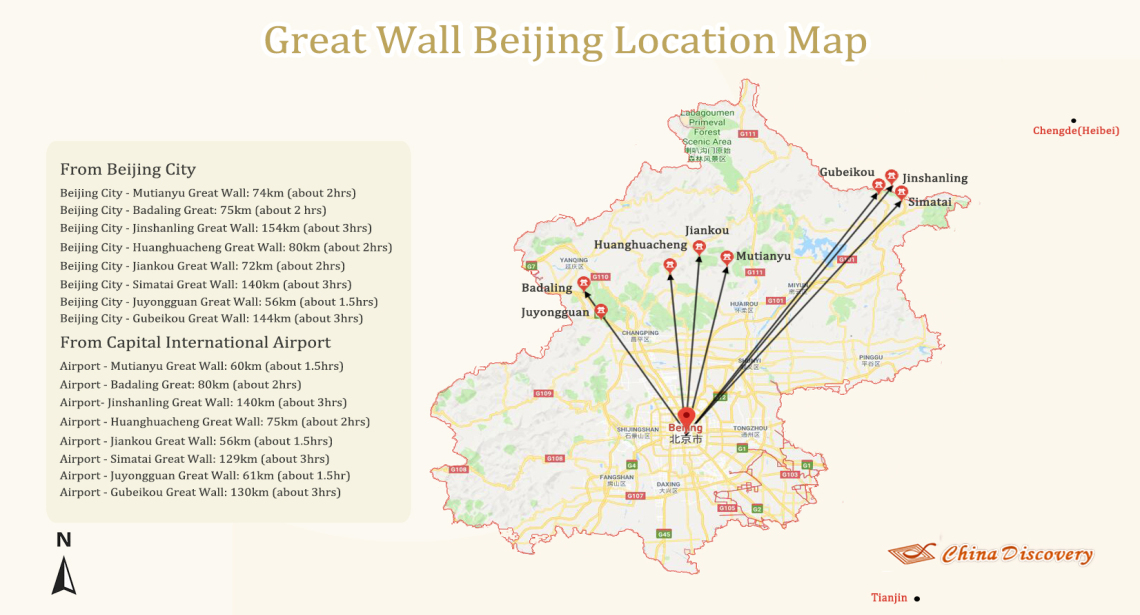
- How to Get to Mutianyu Great Wall
- Location : Bohai Town, Huairou District, Beijing, China北京市怀柔区渤海镇慕田峪村, 75 kilometers (46 miles) from Beijing
- By Private Car : taking a private car is the most recommended way to get to Mutianyu Great Wall. It takes only about 1.5 hours to get there. Your driver can pick up you from your hotel, airport, train station or other locations in Beijing.
- By Bus : You can go to Beijing Tourist Distribution Center (北京旅游集散中心) or Dongzhimen Wai Bus Station (东直门外站) to take tourist buses to Mutianyu Great Wall. These buses only depart during 8:30am-9am, and return from the Great Wall at around 16:00. Beijing Tourist Distribution Center (北京旅游集散中心) is located near Tian’anmen Square, and connected by metro Line 2. Dongzhimen is about 7km away from Tianmen Square and you can get there by metro Line 2, metro Line 13 and several public buses.
- How to Get to Jinshanling Great Wall
- Location : Hualougou, Bakeshiyin Town, Luanping County, Heibei 河北省承德滦平县巴克什营镇花楼沟村160 kilometers (100 miles) from Beijing
- By Private Car : using a private transfer service arranged by a travel agency can save you from the crowdedness of public buses. It takes only about 2.5 hours to get to the entrance of Jinshanling section of Great Wall.
- By Bus : There are usually 4 daily tourist buses running from Dongzhimen Wai Bus Station (东直门外站) for Jinshanling Great Wall, but only operating during April ~ October. It takes about 3 hours to get to Jinshanling. You can get to Dongzhimen Wai Bus Station by metro Line 2 or 3.
- How to Get to Simatai Great Wall
- Location : Simatai, Gubei Ancient Town, Miyun District, Beijing北京市密云区古北水镇司马台村,150 kilometers (94 miles) from Beijing.
- By Private Car : pick up you from your hotel, airport, train station or other locations in Beijing, and need only about 2.5 hours to get to Simatai.
- By Bus : Simatai Great Wall belongs to the Gubei Water Town Scenic Area. You can take a tourist bus from Dongzhimen Wai Bus Station (东直门外汽车站) to Gubei Ancient Town first, then walk for several minutes to Simatai section of Great Wall. The morning bus departs at around 8am, and the afternoon bus departs at around 15:30.
- How to Get to Badaling Great Wall
- How to Get to Huanghuacheng Great Wall
- How to Get to Jiankou Great Wall
- Get from Beijing to Great Wall
- Travel from Beijing Airport to Great Wall
- Beijing South Railway Station to Great Wall
- Beijing West Railway Station to Great Wall
How to Get Around Great Wall of China
Walking is the major way to get on and around the Great Wall. But usually one need to hike on some mountain paths to get on to the wall and towers from the entrance of the scenic zones. For those who are not in good physical condition or want to save energy and time, you can take cable cars up and down at Badaling, Mutianyu, Jinshanling and Simatai sections of Great Wall. The wild sections of Great Wall at Gubeikou, Jiankou, Huanghuacheng, Jinshanling (unrestored part), Simatai (unrestored part) have no cable cars. Taking toboggan down the Great Wall is also very popular among tourists. Currently only Badaling and Mutianyu have toboggans.
- Mutianyu Great Wall Cable Car
- Mutianyu Great Wall Toboggan
- Badaling Great Wall Cable Car and Toboggan
- Get from Jinshanling to Simatai
- Get from Jiankou to Mutianyu
- Get from Gubeikou to Jinshanling
Useful Great Wall of China Maps
To help you know better about location, transportation and attractions of Great Wall of China, here we prepare some useful Great Wall maps. Please feel free to read and download. Contact us if you have any question about the Great Wall.
Mutianyu Great Wall Maps
Badaling Great Wall Maps
Jinshanling Great Wall Maps
Simatai Great Wall Maps
Jiankou Great Wall Maps
Huanghuacheng Great Wall Maps
Great Wall Google Map
More Great Wall Maps
Most Popular Great Wall Tours 2024/2025
No matter it is your first, or the second or the third trip to the Great Wall, China Discovery will always find a suitable tour package for you to see and experience the Great Wall in the best way. If you are one of the first-timers, you are suggested to visit Mutianyu section of Great Wall or Jinshanling Great Wall. If you are the second-timers, it's time to take a memorable hike to those wild section of Great Wall, such as Simatai, Jiankou, Gubeikou, Huanghuacheng, etc. If you still have no idea where to start, you can contact us to design a tailor-made Great Wall trip for you!
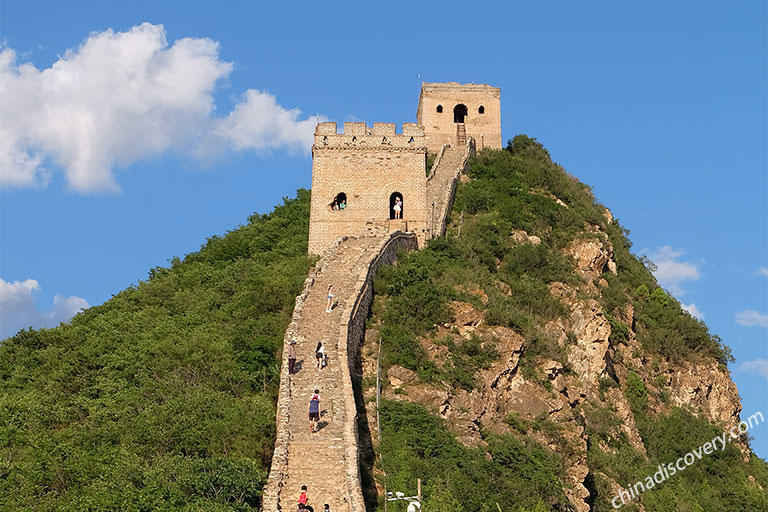
Jinshanling Great Wall, Simatai Great Wall

Great Wall Section(s): Mutianyu/Huanghuacheng
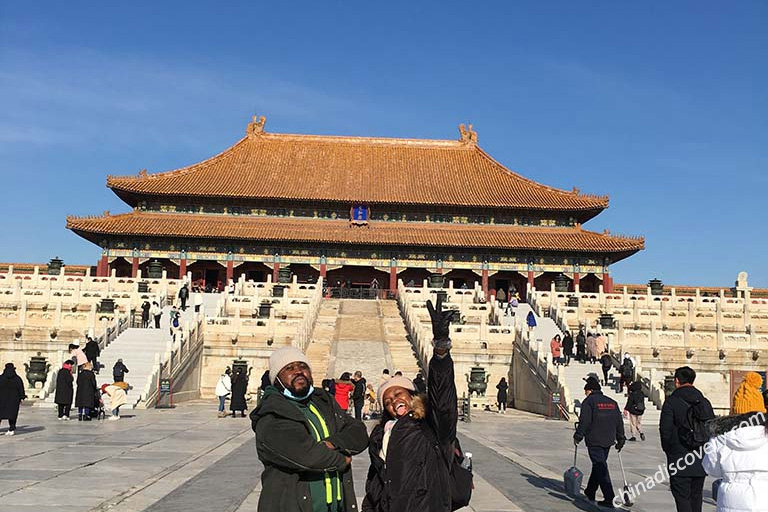
Forbidden City, Jingshan Park, Mutianyu Great Wall, Hutong, Bird's Nest, Water Cube
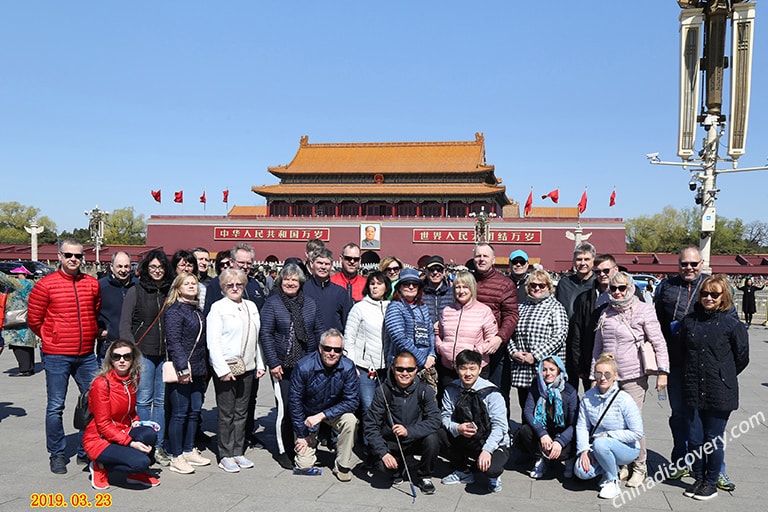
Great Wall Section(s): Jinshanling
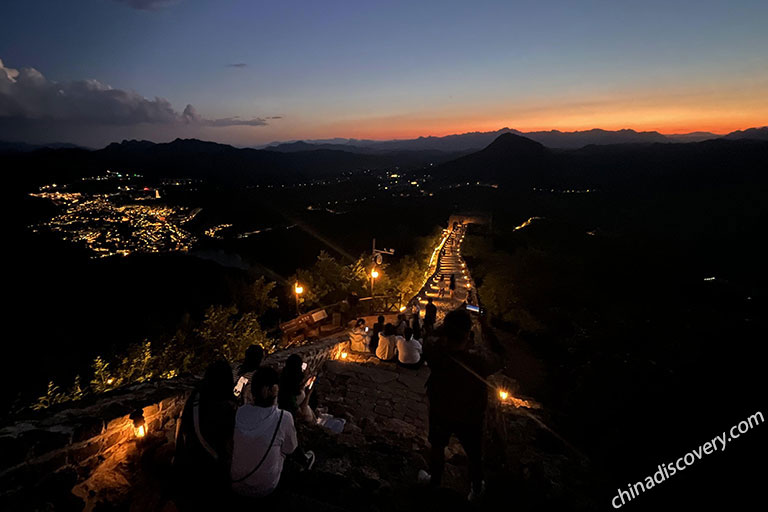
Great Wall Sections: Jinshanling + Simatai
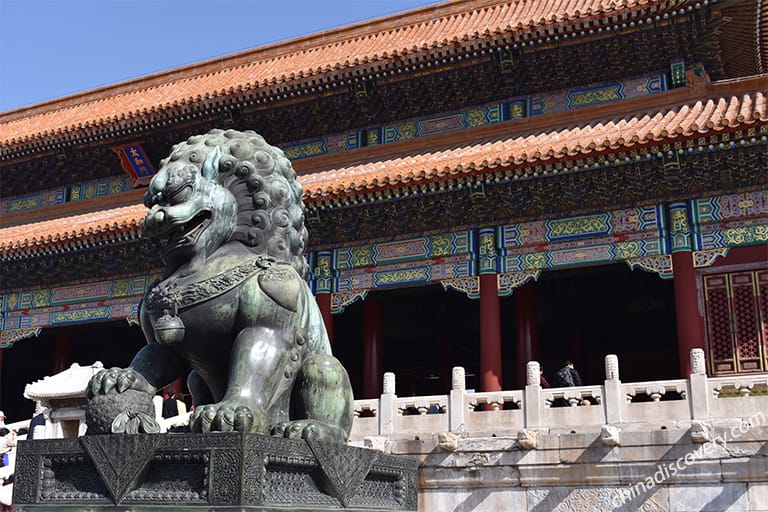
Great Wall Section(s): Mutianyu
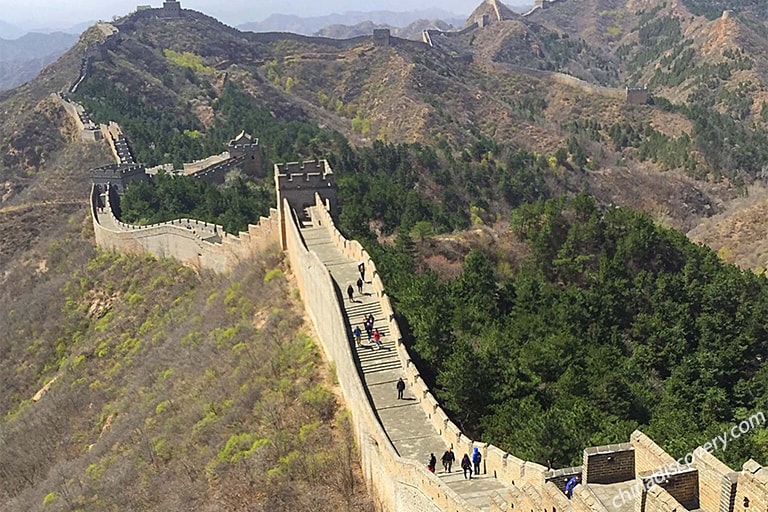
Forbidden City, Terracotta Warriors, Jinshanling Great Wall hiking, Mount Huashan hiking
Start planning your tailor-made holiday to China by contacting one of our specialists. Once inquired, you’ll get a response within 0.5~23.5 hours.

- Affordable and valuable price
- 100% tailor-made packages
- Highly rated customers reviews
- Efficient customer support
China Tours
- Top 10 China Tours
- Classic China Tours
- China Tours from Beijing
- China Tours from Shanghai
- China Tours from Hong Kong
- China Tours from Chengdu
- Short China Trips
- Customize China Tour
- China Panda Tours
- Family Tour with Kids
- High-Speed Train Tour
- Silk Road Travel
- Yangtze River Cruise
- Hiking & Trekking Tours
- Photography Tours
- China Minority Travel
- Beijing Shanghai Tours
- Shanghai Yangtze Tours
- Chengdu Jiuzhaigou Tours
- Chengdu Lhasa Tours
- Suzhou Hangzhou Tours
- Guilin & Yangshuo
- Zhangjiajie
“Very good experience”
“WONDERFUL 25 DAYS IN CHINA - PRIVATE TOUR”
“Awesome China tour from northeast to southwest”
Any questions, please email us at: [email protected] or call us at: 86-19138970032 (Monday-Friday 9 a.m. to 6 p.m. GMT+8)
- Terms & Condition
- Privacy Policy
- Customer Support
Copyright © 2011-2024. All rights reserved.
Cookie policy
We use cookies to give you the best experience on our website. Continue using our website means you agree with our cookie policy. For more info, please read here .
Tiananmen Square
Forbidden City
Best Restaurants
Foods to Try
Nightlife in Beijing
Best Time to Visit
Weather & Climate
Beijing Airport Guide
Top Neighborhoods
Getting Around
Three-Day Itinerary
Things to Do
Shopping Streets
Great Wall of China
A Complete Guide to Visiting the Great Wall of China
bjdlzx / Getty Images
- How to Visit
Huanghuacheng
Jinshanling, tour or solo, how long to spend, where to stay.
The Great Wall of China stretches 13,000 miles over mountains, forests, reservoirs, and desert. It took a millennium to build, involved multiple dynasties, and pissed off a lot of Huns. Inextricably tied to the history of the country, to visit China without seeing it would cause you to be remiss not only with your friends and family at your homecoming, but somehow within yourself as well. To stand on its ramparts gives one simultaneously a sense of experiencing something collectively epic and individually infinitesimal.
Before you visit, decide if you want to go to an unrestored section, wild section or both. (“Wild” is a popular way to refer to the unrestored sections of the wall.) Consider physical ability and whom you’re traveling with (old people, kids, your sister who hates walking) when choosing a section.
This will be a workout. It’s not strolling on an elevated side walk. The Great Wall is stone waves steep and undulating. Grab your hiking boots and prepare for the walk of a lifetime.
How to Visit the Great Wall
Most visitors go to the Great Wall as part of a half or full day trip from Beijing. Visitors can choose from over 12 well-known sections and access them through a group tour, private driver, private tour, public transportation (sometimes combined with taxis), or by driving their own car. While the travel time from Beijing varies depending on section and traffic, it can take anywhere from one to three hours to get to there.
Worthwhile sections to visit in other provinces are the famous packed-earth Jiayuguan section in Jiayuguan, Gansu Province. It's a mere 4 miles (6 kilometers) from the city and easily accessible by public transport or a short taxi ride. Also, Ningxia Province’s Sanguankou section with its three passes is about 25 miles (40 kilometers) from the province's capital city of Yinchuan. It can be reached by hiring a private car.
If you want to hire a tour operator for a section near Beijing, Beijing Wonder Tour has affordable rates and English-speaking guides. Beijing Hiker’s offers hiking tours to the wild wall. If you want to hire a private car with an English-speaking driver but explore the wall on your own, you can choose from a number of options here . If you want to hire your own car, Hertz rents cars from the Beijing airport.
Best Parts of the Great Wall
The Great Wall spans nine provinces. The sections most commonly recommended are all close to Beijing. However, for less touristy and wilder parts of the wall, you can head to Gansu, Ningxia, or several other provinces less frequented by visitors. All of the ones listed below can be accessed from Beijing.
Popular among foreign tourists and easily accessible from Beijing, Mutianyu offers a well-restored wall with 23 watchtowers, replete with photo ops and views of the surrounding mountains and forests. You can hike, take a chair lift or cable car to the top, and toboggan down. It takes about two hours to walk the 1.4 miles of this section. If you go beyond tower 23, the wall is not restored, has no guardrails, and tourists are responsible for their own safety.
To get there hire a private driver or take the subway to Dongzhimen station. Walk upstairs to the North Bound Platform. Take the Express Bus 916 towards Huairou. After about an hour, get off at the Beidajie stop. Take bus H23 to Mutainyu or share a car with other tourists going there. Travel time is two to two and a half hours.
Simatai's main draw is night tours. Though Badaling is also open at night, Simatai has more ambient lighting and fewer crowds. You can take the cable car up and walk this 3-mile section for about one and half to two hours. Be aware that its grade increases rapidly (from 968 to 3,235 feet) and is super steep. The Simatai wall cuts through the Simatai Reservoir, and those who want to can zipline over it. For the day hikers, Heavenly Ladder and Sky Bridge are two extremely narrow and high parts of the wall with incredible views of mountain ridges.
To get there hire a private driver, or hop on the Airport Express subway line to Dongzhimen station. Take Bus 980 from Dongzhimen Long Distance Bus Station to Miyun Town and then take a taxi.
This section's surrounding countryside boasts a sea of yellow flowers in spring and summer. Other distinguishing features of Huanghuacheng include: boat rides on Haoming Lake, and fewer crowds than Mutianyu and Badaling. It can also be combined with Mutianyu for a day trip, as the two sections are only a 40-minute drive apart.
To get there hire a private car, or take the 916 bus or 916 express bus to Dongzhimen to Huairou Bus Station. Hop on the H21 bus to the Small West Lake (Lakeside Great Wall) Station, and walk north to the scenic area. By public transport, it will take at least two hours from central Beijing.
For those who can’t decide if they want to see a restored or wild section of wall, Jinshanling offers a beautiful mixture of both. Ideal for hikers, this section stretches 6.5 miles, runs along the Jinshanling Mountains, contains 67 watchtowers, five mountain passes, and very few tourists. If you hike in this section by itself, plan for two to five hours. You can also hike from this section to other sections, such as Simatai or Gubeikou.
To get there, hire a private driver or take the subway to Wangjing West Station. Hop on the bus to Luanping, and get off at Jinshanling Service Area. This bus will take about two hours to get to Jinshanling Service Area. Once you alight, you can take a free shuttle to the wall.
If you want to see the section of the wall closest to Beijing and can handle huge crowds, this will be your option. Though super touristy, Badaling has amazingly restored wide walkways and guardrails for its steeper parts. Like the Mutianyu section, it offers a cable car and toboggan rides for those who want to save their energy and feet. Plan for one and a half hours to visit this section of the Wall and walk the 2.3 miles of its restored path. Check out the 19 watchtowers along the way and be prepared for tons of hawkers.
To get there hire a private driver or take the subway to Jishuitan station. Go out exit B2 and hop on the 877 bus, a direct bus with a travel time of about one and a half hours to get there.
Tips for Visiting the Great Wall
Use these tips to make the most of your visit.
You do not need to book a tour to the Great Wall, though it can eliminate the stress of trip planning and language barriers. If you are traveling solo or with one or two other adults, hiring a driver or using public transport will most likely be your best options.
If you are traveling in a large group or with children or with elderly family members, a tour or private driver will be your best options. Some tours will take you to a government sponsored tea house or jade museum during the trip. Know what you’re buying if you go the tour route, and look for tours that state they do not do commissioned stops.
Weather-wise, spring and fall are the best times to see the Great Wall. Spring will provide beautiful verdant greens (and yellow blossoms around Huanghuacheng). In the fall, the rolling forested hills on either side of the wall will be dappled with red, orange, and yellow leaves. However, the best time to go to avoid crowds is winter.
Wear layers. It gets windy and most of the sections are exposed. Even the watchtowers have giant open window frames. If you go in the summer, take a hat and sunscreen.
Spend at least three to four hours on the wall, this is one of the Seven Wonders of the World and a UNESCO World Heritage site after all. Take some time to enjoy it. Sections can be steep (even if restored) and ascents slow. Stroll through the blockhouses and watch towers, sip water as you admire the surrounding hills, and zip down to the base in a toboggan (if you go to Badaling or Mutianyu).
If you want to experience the Great Wall early without leaving Beijing in the wee morning hours, consider staying at a hotel by the section you want to see. For Muitanyu, The Brickyard offers comfortable rooms, a restaurant, and a spa. Alternatively, if you want to go to the wall during the day, but also see it lit up at night, go to Simatai. Stay at Gubeishui Town Hotel and splurge on a luxury room with great views.
For intrepid explorers, it is possible to camp on the wall. However, you will need to do your own research and take all of your gear and provisions with you. There are no vendors in the wild sections. If you want to camp in a group tour, Great Wall Hiking offers what is sure to be a memorable experience of a night on the Great Wall.
The 12 Best Day Trips from Beijing
Getting To and From LaGuardia Airport in NYC
Visitor's Guide to the Terracotta Warriors Museum in Xi'an
3 Days in Beijing: The Ultimate Itinerary
Beijing Guide: Planning Your Trip
A Guide to Airports in Beijing
The Top 19 Things to Do in Beijing
Interesting Facts About the Great Wall of China
How to Visit Los Angeles Without a Car
How to Travel From Cancun to Cozumel by Bus, Car, Ferry, and Plane
The Most Crowded Places in China
How to Travel from Phoenix to Sedona by Bus, Shuttle, and Car
Great Activities for Kids Visiting China
The 10 Best Hikes in China
Your Trip to the Amalfi Coast: The Complete Guide
How to Travel from Amsterdam Airport to City Center by Train, Taxi, Bus, and Shuttle
- Find a Tour
- China Tours
- Student Tours
- MICE Travel
- Destinations
- Virtual Tours
Great Wall of China

- Travel Guide
- Private Tours
- Sights & Activities
As China's most famous attraction, the Great Wall of China is an essential stop on all China tours . Commonly considered a wonder of the world, the Great Wall boasts a history of over 2,000 years and stretches more than 3,000 miles across several provinces of northern China, making it one of the most impressive ancient structures on the planet.
Virtual Tour of the Great Wall of China
Want to visit the great wall of china spontaneously with a professional live guide learn more about our guided virtual tour here, best sections to visit.
Beijing is usually considered the main gateway to the Great Wall, since there are several world-famous sections of the Wall in the suburbs of Beijing, including Badaling, Mutianyu, Jinshanling, Juyongguan, Gubeikou, and Jiankou. These sections were built during the Ming dynasty between the 14th and 17th centuries and have been well preserved.
Of all the sections of the Great Wall near Beijing, Badaling is the most famous one. As a result, Badaling is the destination of choice for many large tour groups and is often very crowded. The nearby Juyongguan Great Wall features one of the three great mountain passes of the Great Wall but is almost as crowded as Badaling.
Mutianyu Great Wall is just as close as Badaling and offers wonderful views of the Great Wall and the surrounding hills with far fewer tourists. This section of the Wall also features a thrilling toboggan run that you can ride from the top of the Wall down to the bottom of the hill.
Due to their proximity, Badaling, Juyongguan, and Mutianyu are all doable as a half-day trip from downtown Beijing. We usually recommend Mutianyu over Badaling or Juyongguan , since the massive crowds at the latter two sections can ruin one's experience of this impressive structure.
Further away from Beijing, Jinshanling Great Wall is about 150 km northeast of downtown and it usually takes about two and a half hours to drive there. Despite the longer drive, Jinshanling is among the most stunning sections of the Great Wall. If your itinerary allows for one full day seeing the Great Wall, then we highly recommend a tour to Jinshanling.
Gubeikou and Jiankou can also be visited within a day tour from Beijing . Both sections have not been restored since they were first built in the Ming Dynasty, making them ideal choices for those who want to hike and experience the wild Great Wall. Do be aware that the Jiankou section features very steep and dangerous climbs and is only suitable for experienced hikers.
There are also some other famous sections of the Great Wall within or outside Beijing, such as Huanghuacheng, Simatai, and Shanhaiguan, but we only recommend these if you are visiting the Great Wall for a second time or planning a multi-day, in-depth Great Wall tour.
Great Wall Hiking and Camping
Due to its original purpose as a military defense, almost all sections of Great Wall were built on mountain ranges and thus involve some challenging climbs and uneven stairs, including the well-restored sections. If you are visiting a restored section but hike to the end of the renovated part, you will be able to see the unrestored part of the Great Wall.
For most visitors, Mutianyu and Jinshanling offer good, medium difficulty hikes, while still being very safe. For those looking for a serious hike along wild, unrestored portions of the Wall, we suggest the Jinshanling to Jinshanling East , or Gubeikou to Jinshanling routes. All these routes boast both unrestored and picturesque renovated sections of the Wall. However, please be aware that hikes along wild, unrestored parts of the Great Wall involve many steep climbs and loose bricks, and can be very dangerous in some places. (People can no longer hike through from Jinshanling to Simatai since the route was closed years ago.)
Camping on the Great Wall is usually banned, especially on the renovated sections. If you want to spend a night sleeping on the Great Wall , we can take you to a watchtower on the Gubeikou section of the Great Wall to experience the life of an ancient soldier and catch amazing sunrise/sunset views over the Wall.
Best Time to Visit
For all sections of the Great Wall near Beijing, the spring months (April to June) offer temperate weather and are great for climbing. In late April to early May, many trees begin to blossom, making this a particularly beautiful period to visit the Wall. Fall is also a nice time to visit, as temperatures are usually comfortable. October to early November are particularly picturesque, as the tree leaves on the mountains begin to change color. The winter months, from December to February, are cold and can be windy, but there are usually far fewer tourists on the Wall during these months. July and August are hot and humid, and thus not the best for long hikes. In addition, it's best to avoid hiking on the Wall after rain or snowfall because some parts can get very slippery.
You should also avoid visiting the popular sections, such as Badaling, Juyongguan, and Mutianyu, around National Day (the first week in October) and Spring Festival. August is also a busy time for the Badaling and Juyongguan sections, since students are on summer vacation and many families travel to these famous sections with their kids before the new school year starts. Learn more about how to avoid the crowds when traveling in China .
Great Wall of China Private Tour Packages
- Beijing and the Great Wall Day Tour
- 2 days Beijing highlight tour
- 3 days Beijing tour
- Golden Triangle of China - 9 days Beijing, Xian, Shanghai tour
- The Classic China Tour - 13 days Beijing, Xian, Guilin, Yangshuo, Shanghai tour
- The Ancient Capitals - 5 days Beijing, Xian tour
- Tale of Two Cities - 5 days Beijing, Shanghai tour
- More Great Wall tours...
Customize a tour that includes a visit to this destination
Inquiry form.
Take advantage of the search to browse through the World Heritage Centre information.
Share on social media
Unesco social media, the great wall.
- Description
In c. 220 B.C., under Qin Shi Huang, sections of earlier fortifications were joined together to form a united defence system against invasions from the north. Construction continued up to the Ming dynasty (1368–1644), when the Great Wall became the world's largest military structure. Its historic and strategic importance is matched only by its architectural significance.
Description is available under license CC-BY-SA IGO 3.0
La Grande Muraille
Vers 220 av. J.-C., Qin Shin Huang entreprit de réunir des tronçons de fortifications existants pour en faire un système défensif cohérent contre les invasions venues du nord. Poursuivis jusque sous les Ming (1368-1644), ces travaux ont produit le plus gigantesque ouvrage de génie militaire du monde. Son importance historique et stratégique n'a d'égale que sa valeur architecturale.
السور العظيم
قرابة العام 220 ق.م. بدأ كين شين هوانغ يجمع بقايا حصون قائمة ليُشكّل فسيفساء نظام دفاع متسقِ في وجه اجتياحات الشمال. وتتابعت هذه الأعمال أثناء حكم سلاسة مينغ (1368-1644) فأثمرت أعظم إبداع عسكري عملاق في العالم. ولا توزاي أهميّة السور التاريخيّة والإستراتيجيّة سوى قيمته الهندسيّة.
source: UNESCO/CPE Description is available under license CC-BY-SA IGO 3.0
公元前约220年,秦始皇下令将早期修建的一些分散的防御工事连接成一个完整的防御系统,用以抵抗来自北方的侵略。长城的修建一直持续到明代(1368至1644年),终于建成为世界上最大的军事设施。长城在建筑学上的价值,足以与其在历史和战略上的重要性相媲美。
La Gran Muralla
Hacia el año 220 a.C., el primer emperador Qin Shin Huang ordenó reunir los tramos de fortificaciones construidas anteriormente, a fin de crear un sistema de defensa coherente contra las invasiones de los pueblos del Norte. Los trabajos de edificación de la Gran Muralla prosiguieron hasta la dinastía de los Ming (1368-1644), dando por resultado la obra de ingeniería militar mí¡s gigantesca de todos los tiempos. Su gran valor arquitectónico es comparable a su importancia histórica y estratégica.
source: NFUAJ
Chinese Muur
Tijdens de eerste Qin dynastie onder keizer Qin Shi Huang (220 voor Christus) werden gedeelten van vroegere vestingwerken samengevoegd om een uniek verdedigingssysteem tegen invasies vanuit het noorden te vormen. Het bouwen duurde voort tot aan de Ming dynastie (1368-1644) waarmee de Chinese Muur het grootste militaire bouwwerk op aarde werd met een totale lengte van meer dan 20.000 kilometer. De muur begint in het oosten bij Shanhaiguan, in de provincie Hebei en eindigt in het westen bij Jiayuguan, in de provincie Gansu is van buitengewoon belang vanuit historisch, strategisch en architectonisch opzicht.
Source: unesco.nl
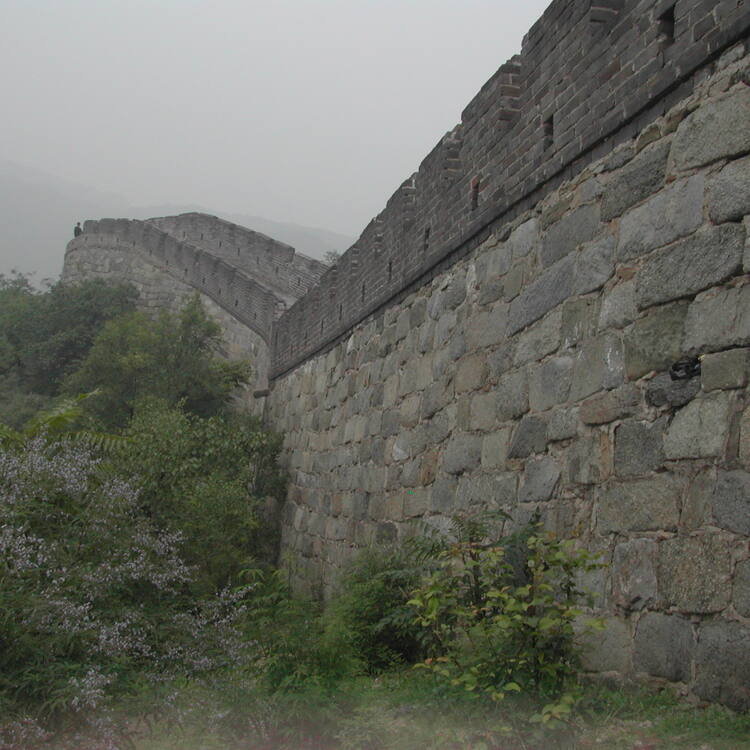
Outstanding Universal Value
Brief synthesis
The Great Wall was continuously built from the 3rd century BC to the 17th century AD on the northern border of the country as the great military defence project of successive Chinese Empires, with a total length of more than 20,000 kilometers. The Great Wall begins in the east at Shanhaiguan in Hebei province and ends at Jiayuguan in Gansu province to the west. Its main body consists of walls, horse tracks, watch towers, and shelters on the wall, and includes fortresses and passes along the Wall.
The Great Wall reflects collision and exchanges between agricultural civilizations and nomadic civilizations in ancient China. It provides significant physical evidence of the far-sighted political strategic thinking and mighty military and national defence forces of central empires in ancient China, and is an outstanding example of the superb military architecture, technology and art of ancient China. It embodies unparalleled significance as the national symbol for safeguarding the security of the country and its people.
Criterion (i) : The Great Wall of the Ming is, not only because of the ambitious character of the undertaking but also the perfection of its construction, an absolute masterpiece. The only work built by human hands on this planet that can be seen from the moon, the Wall constitutes, on the vast scale of a continent, a perfect example of architecture integrated into the landscape.
Criterion (ii): During the Chunqiu period, the Chinese imposed their models of construction and organization of space in building the defence works along the northern frontier. The spread of Sinicism was accentuated by the population transfers necessitated by the Great Wall.
Criterion (iii): That the Great Wall bear exceptional testimony to the civilizations of ancient China is illustrated as much by the rammed-earth sections of fortifications dating from the Western Han that are conserved in the Gansu province as by the admirable and universally acclaimed masonry of the Ming period.
Criterion (iv): This complex and diachronic cultural property is an outstanding and unique example of a military architectural ensemble which served a single strategic purpose for 2000 years, but whose construction history illustrates successive advances in defence techniques and adaptation to changing political contexts.
Criterion (vi): The Great Wall has an incomparable symbolic significance in the history of China. Its purpose was to protect China from outside aggression, but also to preserve its culture from the customs of foreign barbarians. Because its construction implied suffering, it is one of the essential references in Chinese literature, being found in works like the "Soldier's Ballad" of Tch'en Lin (c. 200 A.D.) or the poems of Tu Fu (712-770) and the popular novels of the Ming period.
The Great Wall integrally preserves all the material and spiritual elements and historical and cultural information that carry its outstanding universal value. The complete route of the Great Wall over 20,000 kilometers, as well as elements constructed in different historical periods which constitute the complicated defence system of the property, including walls, fortresses, passes and beacon towers, have been preserved to the present day. The building methods of the Great Wall in different times and places have been integrally maintained, while the unparalleled national and cultural significance of the Great Wall to China is still recognised today. The visual integrity of the Wall at Badaling has been impacted negatively by construction of tourist facilities and a cable car.
Authenticity
The existing elements of the Great Wall retain their original location, material, form, technology and structure. The original layout and composition of various constituents of the Great Wall defence system are maintained, while the perfect integration of the Great Wall with the topography, to form a meandering landscape feature, and the military concepts it embodies have all been authentically preserved. The authenticity of the setting of the Great Wall is vulnerable to construction of inappropriate tourism facilities.
Protection and management requirements
The various components of the Great Wall have all been listed as state or provincial priority protected sites under the Law of the People’s Republic of China on the Protection of Cultural Relics . The Regulations on the Protection of the Great Wall promulgated in 2006 is the specific legal document for the conservation and management of the Great Wall. The series of Great Wall Conservation Plans, which is being constantly extended and improved and covers various levels from master plan to provincial plans and specific plans, is an important guarantee of the comprehensive conservation and management of the Great Wall. China’s national administration on cultural heritage, and provincial cultural heritage administrations where sections of the Great Wall are located, are responsible for guiding the local governments on the implementation of conservation and management measures for the Great Wall.
The Outstanding Universal Value of the Great Wall and all its attributes must be protected as a whole, so as to fulfill authentic, integral and permanent preservation of the property. To this end, considering the characteristics of the Great Wall, including its massive scale, transprovincial distribution and complicated conditions for its protection and conservation, management procedures and regulations, conservation interventions for the original fabric and setting, and tourism management shall be more systematic, scientific, classified, and prioritized. An efficient comprehensive management system, as well as specific conservation measures for the original fabric and setting will be established, while a harmonious relationship featuring sustainable development between heritage protection and social economy and culture can be formed. Meanwhile, the study and dissemination of the rich connotation of the property’s Outstanding Universal Value shall be enhanced, so as to fully and sustainably realize the social and cultural benefits of the Great Wall.
- Great wall at Badaling
- Official website page (in Chinese only)
- Lanzhou University (chinese only)
- Meet the Great Wall (Meet the Great Wall Studio)
- Great Wall of China (TravelChinaGuide.com)

State of Conservation (SOC)
- Skip to content

China travel guide, travel tips, attractions, & funny stuff!
The Great Wall of China | The Complete Guide of Everything To Know
May 5, 2020 By China Mike
S ure you’ve seen photos…but the only way to really appreciate the Great Wall of China is to stand on its walls and stare in awe as it snakes across the Gobi Desert and China’s placid mountains like a majestic ridge-backed dragon.
Through this Great Wall of China Guide, you will get a detailed intro to the Great Wall of China: some interesting facts including who built it, and why, and how, locations, maps, length, height, & more.
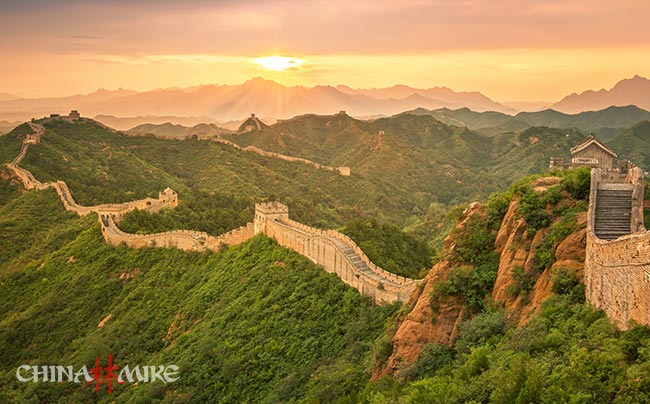
Built by a succession of imperial dynasties over the last two millennia, the network of fortifications and towers has evolved over the centuries—defining and defending the outer reaches of Chinese civilization.
During his famous visit to the Great Wall in 1972, Richard Nixon (in a Bush Jr–esque moment of eloquence) stated: “ I think that you would have to conclude that this is a great wall .” And he was right—the Great Wall of China is undoubtedly one of the ancient world’s most amazing feats of engineering.

To the Chinese, the Great Wall is known as “Wan Li Chang Cheng” (万里长), or literally, “Long Wall of Ten Thousand Li” (“li” is a measure of distance about 500m or about a third of a mile). But of course, that’s not the actual length of the wall, but just an ancient way of saying “this is a long friggin’ wall.”
And although the Great Wall is undisputedly the longest man-made structure ever built, its exact total length continues to be debated since the Great Wall of China is not a single, continuous wall as described by early Western historical accounts. Instead, it’s more accurately described as a patchwork of walls that evolved over the centuries—an overlapping maze of walls and towers that were built (or fell into disuse) by successive dynasties throughout Chinese history.
But one thing is clear: t he Great Wall is one of – if not THE – iconic symbol of China, symbolizing the perseverance and diligence of the Chinese civilization. There simply aren’t many cultural landmarks on the earth that symbolize the sweep of a nation’s history more powerfully than the Wall.
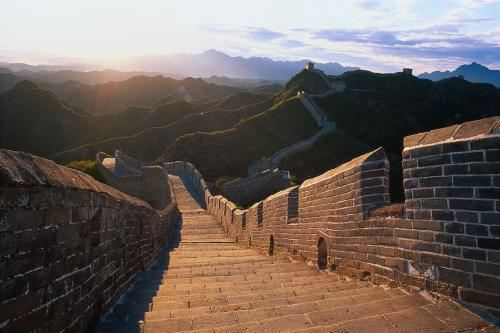
On the other hand, a number of Chinese intellectuals have pointed to the Wall as a symbol of what’s wrong with China – that it’s too conservative, focused on past glory days, and tends to look inward rather than outward.
Similarly, others see it as symbolic of the long-time Chinese practice of trying to keep out foreign cultures and influence, rather than absorbing and learning from them.
In this complete guide to the Great Wall of China, I want to explore some of the most common questions about this iconic structure, walk through a brief history of how it was built (I’ve written a more extensive history of the Great Wall of China here if you’re interested) and explain the best way for you to visit the Great Wall for yourself.
Brief History of China’s Great Wall
Building large-scale defensive walls has a long history in China. Walls often surrounded an entire city to protect against marauding nomads and enemies.
One of the earliest walls dates way back to the Shang Dynasty (1600 – 1050 BC), which built a tall, earthen-wall that enclosed an area of three square kilometers around their capital.
To see some great examples of China’s more “modern” (but still ancient) surviving city walls, head to Nanjing or Xi’an .
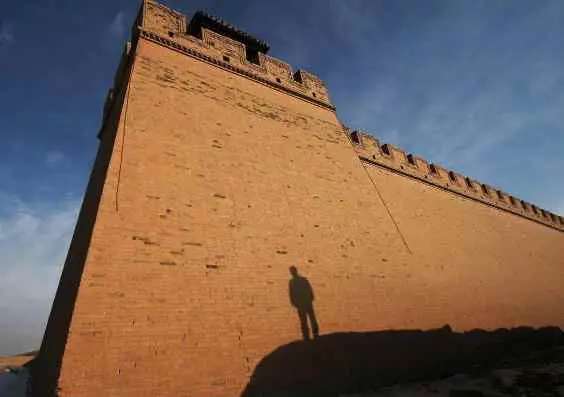
Great Wall 1.0 | The Beginnings
The earliest pieces of the Great Wall were built as early as the 5 th century BC, during the so-called Warring States Period , when rival states constructed fortifications to defend their borders and irrigated lands against their neighbors (as well as non-Chinese nomads from the north).
During this early evolution, the “Wall” was just a growing patchwork of walls used to separate rival territories. The Great Wall as a concept didn’t come into existence until the 3 rd century BC, after the legendary Qin Shi Huang unified China in 221 BC—becoming the founder of the Empire and First Emperor of China.

In 215 BC, he started the gargantuan task of creating the Great Wall 1.0 to protect China from the horse-riding nomadic “barbarians” to the north.
Of course, he personally didn’t lift a finger. But he had between 300,000-500,000 workers— mostly soldiers, prisoners, and unwilling peasants-turned-slaves—doing the dirty work. Though his dynasty was one of China’s shortest, his mark of Chinese history is indelible.
The infamously ruthless and iron-fisted First Emperor also left China with its second most famous tourist attraction: the Terracotta Army —his massive subterranean tomb filled with over 7,000 soldiers (and horses and chariots) to protect him in the afterlife.
In fact, his Great Wall project–along with other major development projects requiring massive labor–caused so much widespread suffering throughout the country that there were several (unsuccessful) assassination attempts on his life.

Great Wall 2.0 | Ming Dynasty Updates
Fast forward to the 15 th and 16 th centuries. The most impressive “modern” sections of the Great Wall were all constructed during the Ming Dynasty (1388-1644 CE).
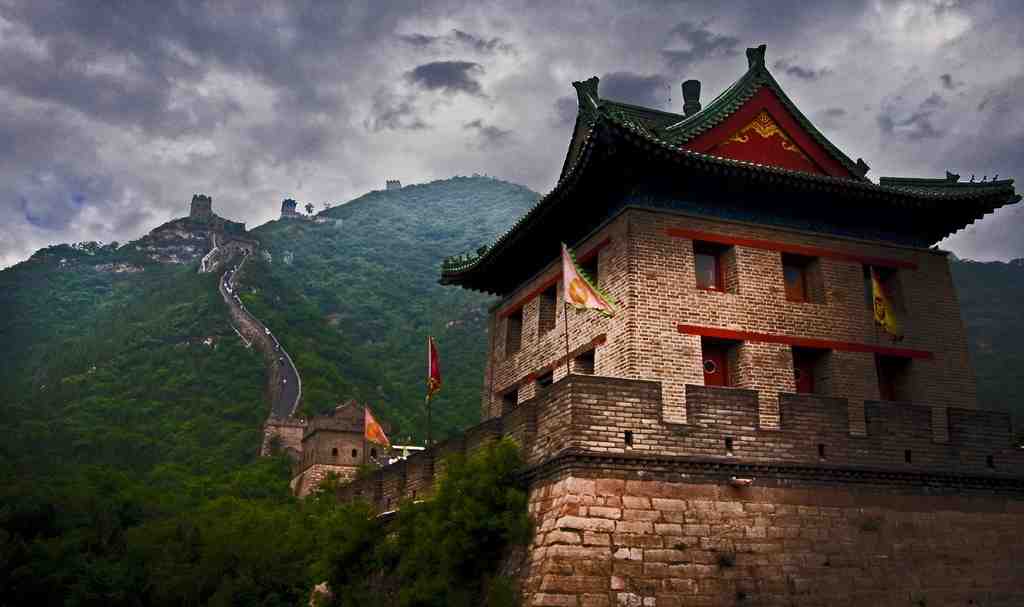
The insular Ming emperors didn’t just fortify parts of the wall…we’re talking about over a 100-year effort to completely rebuild and reinforce the wall using modern brick and mortar construction (and you thought your kitchen renovation project was a never-ending money pit!).
These Ming Walls are the impressive, sturdy brick structures that have made the Great Wall of China a popular tourist destination . They stand at almost 25 feet (7m) high and almost as wide –they were designed so that 10 soldiers or 5 horses could ride side-by-side.
Strategically spaced about 300-500m apart, watchtowers sent signals down the line using smoke, gunpowder, and flags to quickly update leaders in Beijing on enemy movements (you’d think a Twitter feed would be quicker).

Was the Great Wall of China a Failure?
Despite decades of construction and countless lives lost (it’s also referred to as the world’s largest tombstone), the Great Wall never really effectively served its function as a supposedly impregnable line of defense.
Historians all over the world consider the Great Wall of China to have been “failure” as a defensive system, although not because of any inherent design flaws. Instead, it was the human factor— political infighting, corruption, cowardice —that proved to be the weak link throughout the history of the Wall.
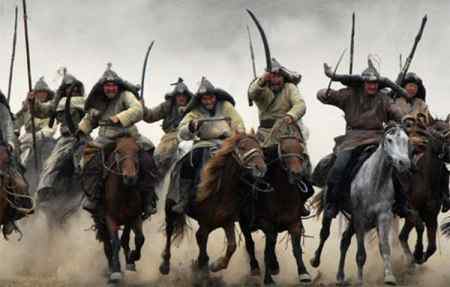
During a six-decade campaign to invade China, the Mongols penetrated the Great Wall and besieged the capital of Yanjing (now Beijing ) in 1215. Mongols were able to regularly find ways of going around sections or through the walls—often by bribing officials and guards.
Genghis Khan was alleged to have said, ‘The strength of a wall depends on the courage of those who defend it.” In 1279, the Mongols completed their takeover, becoming the first (but not last) non-Chinese group to rule the whole of China.
Even the impressive Ming Walls weren’t enough to protect China from being conquered by invaders again in the 17 th century.
In 1644, the (non-Chinese) Manchurian army from the north marched to the Wall at the strategic pass called Shanhaiguan (the First Pass Under Heaven). Since the Ming dynasty was about to be overthrown by an internal rebellion, the Ming general in charge of the pass decided to ally with the Manchus and allowed them to pass through the Wall.
The Manchus did help defeat the rebels…but then took control, declared the Qing Dynasty , and ruled China for next two and a half centuries.
The Legacy of the Great Wall of China
For all the centuries of investment—and blood, sweat, and tears—the Great Wall at least provided some other benefits.
During the Han Dynasty (206BC-220AD), the wall extended farther than any other time in history—largely due to the development of the Silk Road which extended as far west as Rome and Persia.
With traders traveling alongside the Wall in huge camel caravans, the Great Wall enabled the development of the Silk Road, which in turn increased the exposure of different cultures and new ideas, such as Buddhism.
The larger Ming-era Walls served well as a sort of elevated highway, enabling them to more easily move goods, equipment, and people across the mountainous terrain.
And while the wall didn’t effectively serve its original purpose of defending from invaders from the north, it did leave the Middle Kingdom with one of its most iconic and impressive legacies.
Of course, Chinese emperors had no way of knowing that, centuries later, China’s new invaders—the hairy barbarian Western powers—wouldn’t be coming from the north. Instead, they came by sea from the West—bringing superior military technology, opium, and later, brands like McDonalds and CocaCola.
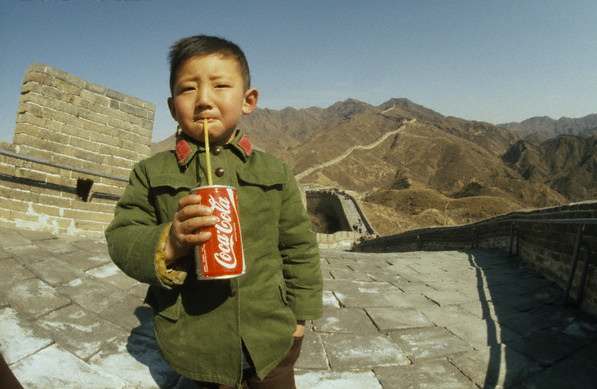
In an ironic twist of history, some historians have commented that the original purpose of the Great Wall was to keep foreigners out…but today it’s responsible for drawing in millions of foreign tourists to China each year.
Now that I think about it, maybe China’s emperors—legendary for forward-thinking strategy—planned it that way all along (“ Some day, those big-nosed laowai will pay big money to come to China to buy cheesy ‘I climbed the Great Wall’ t-shirts. Haha! ”).
Great Wall of China – Common Questions
There are a few common questions that always get asked about the Great Wall of China. I’d like to answer a couple of them here.
1. How Long is the Great Wall of China?
The answer…depends on whom you ask. Again, since the Great Wall isn’t a single wall–but a patchwork of smaller walls built over several centuries— there’s no easy, definitive answer.
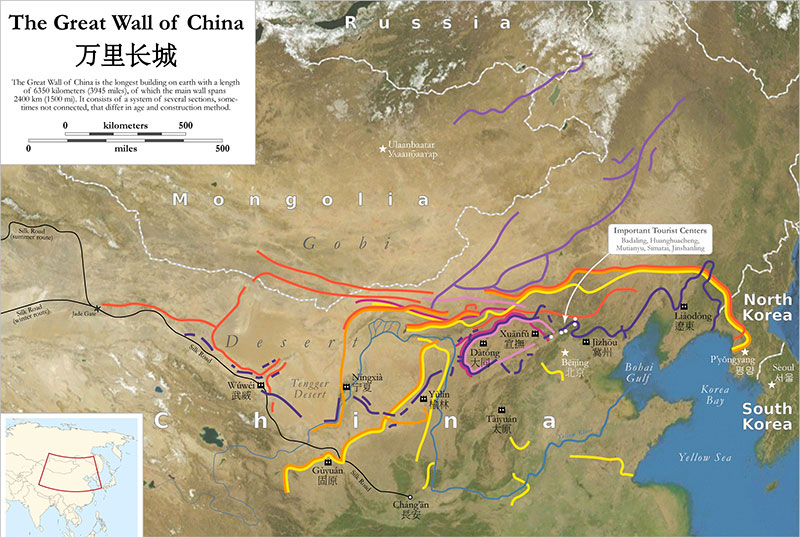
Unfortunately, there are no surviving historical records of the exact length of the “original” Qin Dynasty walls, which were first constructed over 2,000 years ago.
Naturally, most of the ancient walls have eroded away over the centuries (bricks weren’t used until much later during the Ming dynasty). Very few sections of the ancient walls remain standing today. After centuries of erosion, the vast majority of the earth and stone-constructed walls have been lost throughout China’s remote mountains and vast deserts.

Adding to the difficulty in determining an authoritative answer to the exact length of the Great Wall of China, historians are still uncovering sections of the wall.
For instance, in October 2002, a new 50-mile (80km) section of the Great Wall was discovered in northwestern China. Just a few months earlier, in August 2002, Chinese archaeologists discovered some 2,000-year old sections of the wall, dating back to the Han dynasty (206 B.C. to A.D. 220).
So the answer to “How long is the Great Wall of China” depends on how you decide to measure the wall (and what sections constitute the Great Wall).
If you just measure the distance between the Great Wall’s two farthest points, you’d come up with about nearly 6,700 km (or 4,160 miles) . But estimating the actual length of the walls, most estimates have its length between 3,900 to 4,500 miles.
Some estimates—which add together the total length of all of the various walls built during all of the Chinese dynasties—claim that the “total length” is up to 31,000 miles/50,000 kilometers (which personally seems like quite a stretch to me).
The Guinness Book of Records puts the main line length of the wall at 2,150 miles (not including 2,195 additional miles consisting of branches).
China’s Official Answer to Great Wall Length
Though the length of the Great Wall continues to be debated by people who apparently have nothing better to do, the China’s State Administration of Cultural Heritage and the State Bureau of Surveying and Mapping recently conducted the most comprehensive archeological survey of the Great Wall.
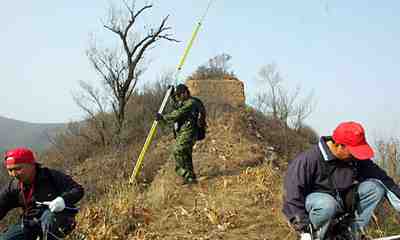
Using advanced infrared range finding and GPS technology, they even discovered new Ming-era sections of the wall in the process. In April 2009, the researchers announced the conclusion of their two-year study.
They put the Great Wall’s total length at 8,851.1 km (about 5,500 miles). So there you have it, a final answer (until someone discovers another section I suppose).
2. Can You See the Great Wall of China from Space?
You’ve probably read somewhere that the Great Wall is also the only man-made structure able to be seen by the naked eye from space (or from the moon).
Is it true? This answer is a bit more straight-forward: NO.
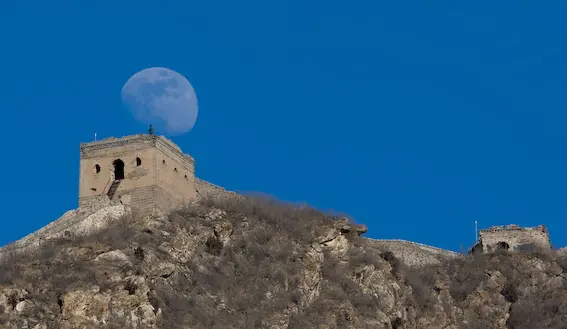
No one knows the origins of this myth, but since it was taught in Chinese textbooks for decades, my money is on an over-enthusiastic but talented official in the government propaganda department (he probably has a very successful career in PR today).
Actually, most sources trace the origins of this myth back to a 1932 Ripley’s Believe It or Not! cartoon that claimed that the Great Wall of China is “ the mightiest work of man, the only one that would be visible to the human eye from the moon .”
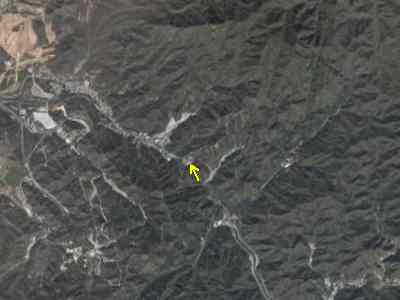
The myth continues today although it’s been debunked many times.
For instance, astronaut Jay Apt—who orbited the Earth 562 times on four Space Shuttle missions from 1991 to 1996—wrote in the November 1996 issue of National Geographic:
“ We look for the Great Wall of China. Although we can see things as small as airport runways, the Great Wall seems to be made largely of materials that have the same color as the surrounding soil. Despite persistent stories that it can be seen from the moon, the Great Wall is almost invisible from only 180 miles up .” Jay Apt
Former NASA astronaut Jeffrey Hoffman—who went on five space shuttle missions from 1985 to 1996—agreed.
“ I have spent a lot of time looking at the Earth from space, including numerous flights over China, and I never saw the wall…the problem is that the human eye is most sensitive to contrast, and the color of the wall is not that different from the ground on either side of it. ” Jeffrey Hoffman
In addition to the problem of lack of contrast, the Great Wall—though undoubtedly long—is only about 25 feet (7m) wide. China’s pollution certainly doesn’t help things either.
Even if the wall were visible from low orbit, the claim that it’s the ONLY man-made object visible is not true. In addition to being able to see cities at night, NASA astronauts have been able to see large structures, including airports, bridges, dams, and reservoirs during the day.

So clearly if the Great Wall isn’t visible by the naked eye from 180 miles away, it would not be visible from the moon, which is 238,855 miles (384,400 km) above Earth.
As if we needed additional evidence, Apollo 11 astronaut Neil Armstrong has repeatedly stated that the wall is “ definitely not visible from the Moon “. Similarly, when asked if it was possible to see the Great Wall from the moon, Apollo 15 astronaut Jim Irwin answered that it “ is out of the question “.
NASA even debunks the myth on their own website: “It has become a space-based myth. The Great Wall of China, frequently billed as the only man-made object visible from space, generally isn’t, at least to the unaided eye in low Earth orbit. It certainly isn’t visible from the Moon.” (May 2005)
Not ready to give up hope on their national point of pride, the Chinese were hoping that their own astronaut, Yang Liwei (first Chinese person in space) would give their eager reporters some good news after a 2003 mission.
He admitted that he couldn’t see it, eventually resulting in the Ministry of Education to finally remove that erroneous tidbit from their textbooks (I’m sure there were a lot more inaccuracies that they could’ve remedied too!).
But some urban (space) myths die hard. The issue came up again in 2004 after Leroy Chiao—NASA science officer of the International Space Station— took some photos that showed some sections of the Great Wall about 200 miles north of Beijing (aided by contrast from recent snowfall).
Despite the facts that the photos were taken with a telephoto lens and Chiao said that he personally couldn’t see the wall (or was even sure if the photos showed it), the photos were enthusiastically greeted by the Chinese with rejoicing and prominently featured in newspapers (“ Hey Wong, get the textbook printer back on the phone! ”)
Further Great Wall of China Info
If you think this is everything there is to know about the Great Wall of China…you would be mistaken! I’ve written quite a bit about China’s Great Wall that you might find helpful as you continue your research.
- Great Wall of China | History & Facts : Get a deeper understanding of the history of China’s Great Wall and what makes it so unique. I barely scratched the surface above, so if you have an interest in history, you’ll want to read this.
- How Did They Build the Great Wall of China? Another great question that I wanted to dedicate an entire article to. When you think about well this Great Wall has endured the test of time, you’ll understand why it’s important to understand how it was built.
- Defending the Wall : I briefly mentioned above how most people consider the Great Wall of China to be a failure (except China, of course). In this writeup, I discuss exactly how it was defended and where those failures came from.
- Great Wall of China Tourist Guide : Are you planning to visit the Great Wall yourself? Read through this helpful tourist guide before you go.
- Maps of China’s Great Wall : A collection of maps about the Great Wall of China, including tourist maps, 3D maps and others.

Photos of The Great Wall of China
Below you’ll find some great examples of photos of the Great Wall of China, broken out by section. It’s possible to visit each section of the Great Wall, but some are easier for tourists than others.
Badaling Section of the Great Wall of China
The Badaling section of the Great Wall of China is probably the most popular that a tourist can visit.
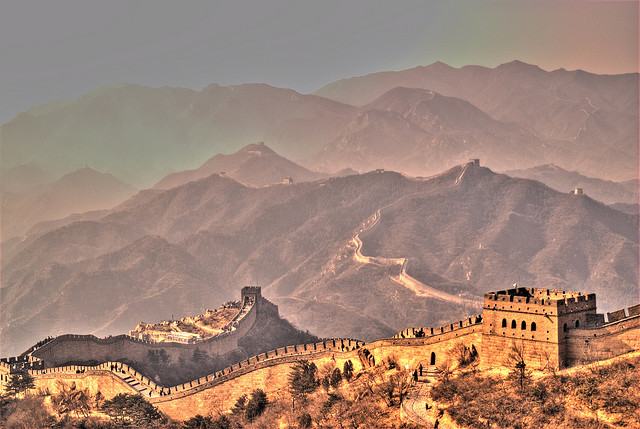
Mutianyu Section of the Great Wall of China
Mutianyu is a section of the Great Wall of China located in Huairou District within the city limits of Beijing 70 kilometres northeast of the center of the city. The Mutianyu section of the Great Wall is connected with Jiankou in the west and Lianhuachi in the east.
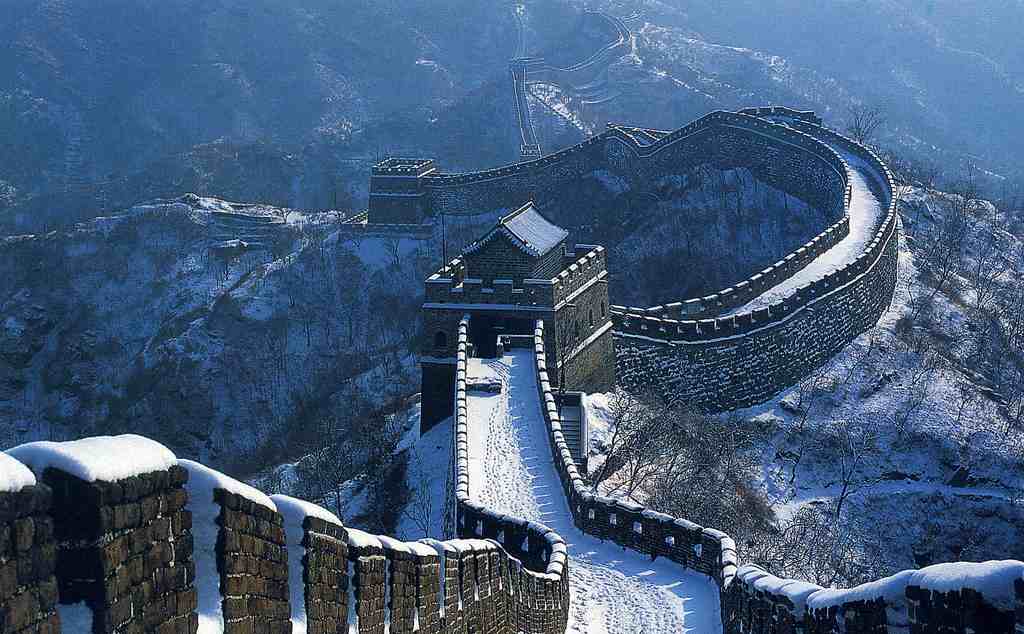
Juyongguan Section of the Great Wall of China
Juyongguan (Juyong Pass) Great Wall is one of the three most famous passes along the Great Wall of China, together with Jiayuguan and Shanhaiguan.
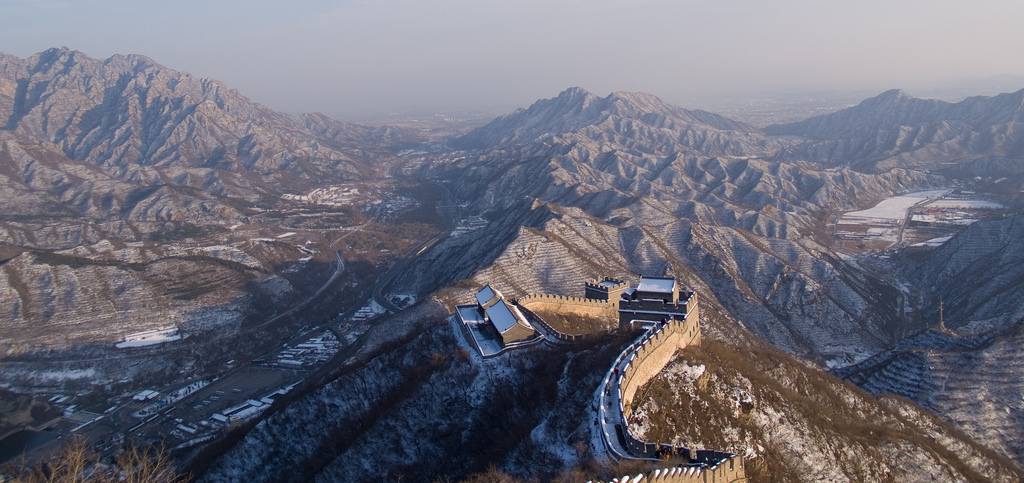
Simatai Section of the Great Wall of China
Simatai is located in the north of Miyun County, 120 km northeast of Beijing, holds the access to Gubeikou, a strategic pass in the eastern part of the Great Wall. It was closed in June 2010 but has been reopened to tourists in 2014.
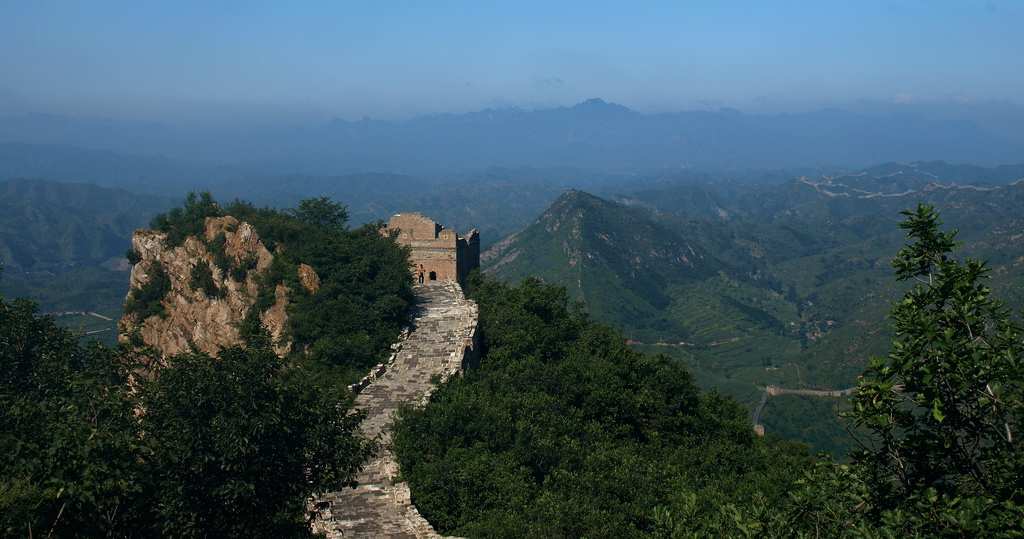
Jinshanling Section of the Great Wall of China
Jinshanling is a section of the Great Wall of China located in the mountainous area in Luanping County, Hebei Province, 125 km northeast of Beijing. This section of the wall is connected with the Simatai section to the east. Some distance to the west lies the Mutianyu section.
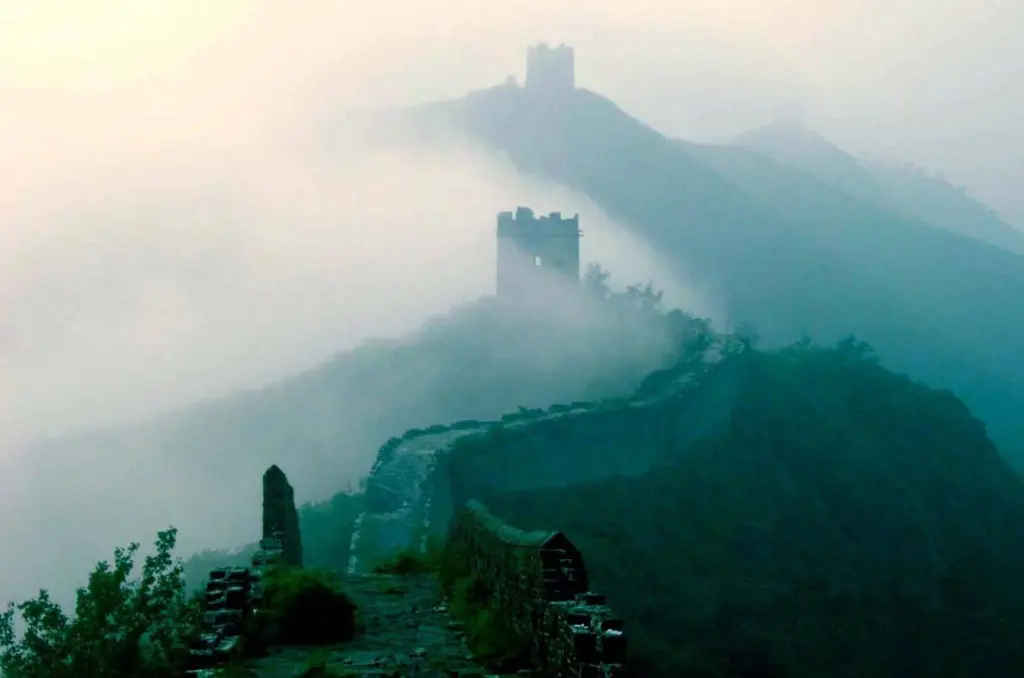
Jiankou section of the Great Wall of China
Jiankou Great Wall is one of the most dangerous and wild Great Wall sections. It is also the most photographed section due to its precipitous mountains, unique construction style, and attractive scenery.
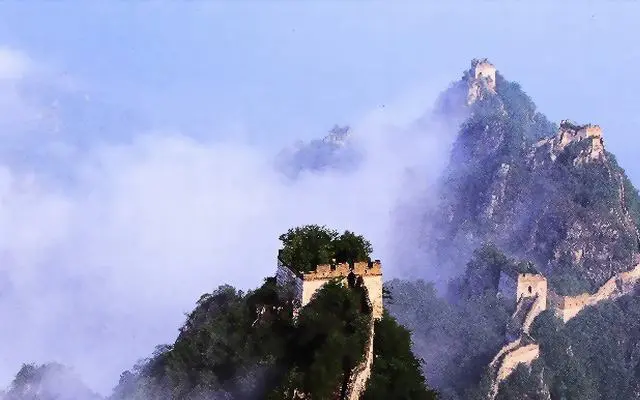
Conclusion | The Great Wall of China
It may not be visible from space, but as Nixon said, you would have to conclude that this is a great wall!
To truly appreciate the beauty and majesty of such a huge engineering marvel, you really need to visit the Great Wall for yourself. It’s only when you’ve exhausted yourself climbing an unbelievably steep set of stairs or seen the wall stretch as far as the eye can see that you find yourself scratching your head.
The fact that The Great Wall even exists is amazing.
But I guess that’s why it’s such an iconic part of China’s history and modern culture. It truly is a “Great Wall”.

Related Posts
- Facts about China: INFRASTRUCTURE
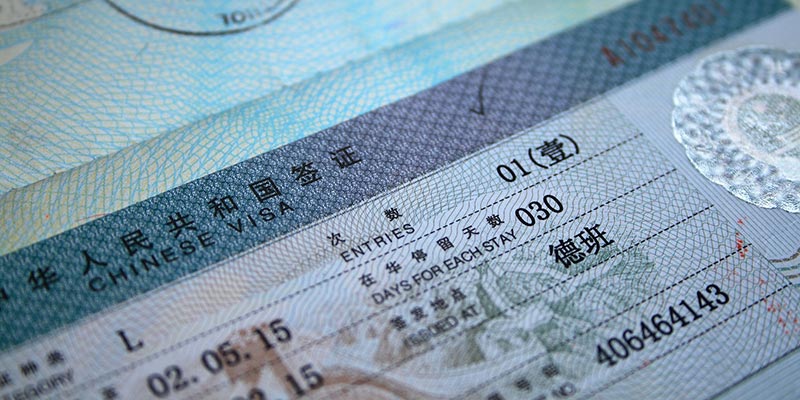
About China Mike
China Mike offers trusted resources about China and its history based on more than a decade of study and personal travel experience. His knowledge and writing on China has been used and referenced by universities, news publications and numerous online blogs.
China Travel Resources
Are you looking for quality China travel resources? Check out this breakdown of my favorite travel tips and resources.

Touropia Travel Experts
Discover the World
10 Best Places to Visit the Great Wall of China

Stretching for over 6,000 kilometers, the Great Wall of China is undoubtedly one of humankind’s most impressive architectural and engineering achievements. Over the centuries and millennia, various Chinese states and empires built sections of the wall to protect themselves from roving nomadic groups that threatened their territory from the north. As such, some parts date all the way back to the seventh century BC, while some of its most famous segments were only added in the 1500 and 1600s.
Snaking its way along mountain ridges through valleys and hills, the Great Wall stretches all the way from the Gobi Desert in the west to the Bohai Sea in the east and passes through 15 Chinese provinces along the way.
While many of its best-preserved and most impressive looking segments are to be found just outside Beijing, other more wild and remote, yet equally scenic parts are to be found further afield. As it is one of the most famous and iconic monuments in the world, no visit to China can ever be complete without taking a stroll along the Great Wall.
10. Shanhaiguan [SEE MAP]
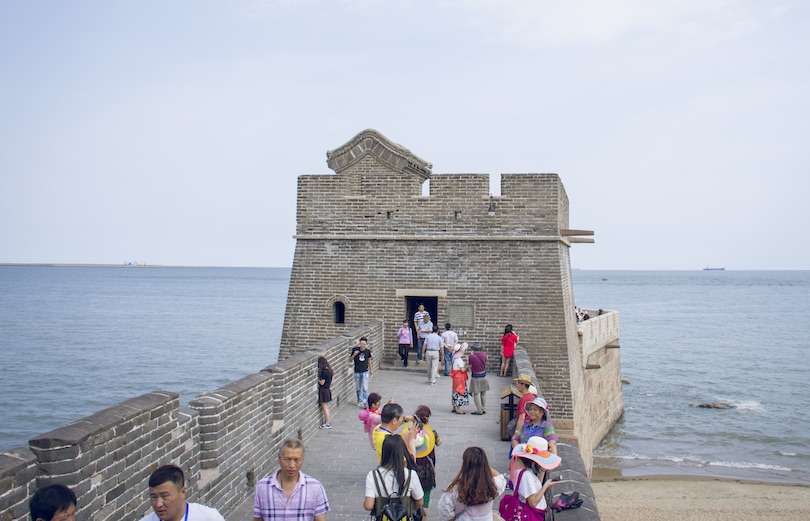
Known as the ‘Dragon’s Head,’ it is at Shanhaiguan that the Great Wall finally comes to an end and protrudes so dramatically into the Bohai Sea. Although the original part has long since crumbled into the waves, the wall has been fantastically rebuilt and restored, so you can snap photo after photo from atop of it of the sea smashing against it.
The old fortifications that surround the town of Qinhuangdao, where Shanhaiguan is located, are also considered to be part of the Great Wall and are well worth exploring if you have the time. Large segments are unrestored, and these offer up a possibly more authentic experience than the somewhat touristy Dragon’s Head. In addition to this, the town also boasts a brilliant museum that will teach you everything there is to know about the Great Wall and the people that once manned it.
9. Huangyaguan [SEE MAP]
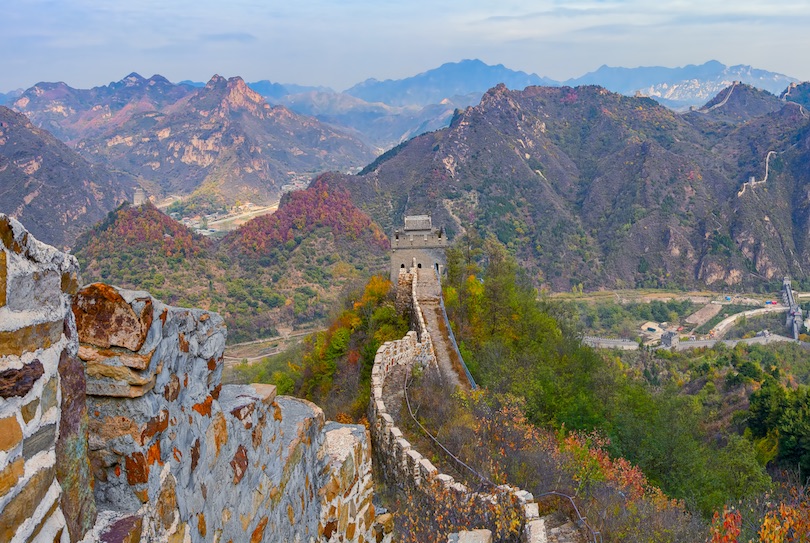
Set amid some absolutely stunning scenery with beautiful mountains and valleys all around it, the Huangyaguan section of the Great Wall stretches some 40 kilometers and boasts lots of impressive towers and water gates. The latter are particularly interesting to visit, as the arches – which date to the 1400s – could be opened and closed depending on whether an enemy was approaching or not.
Although it is quite steep in a lot of places, the wall makes for some fabulous hiking. Every May, thousands of keen runners descend upon Huangyaguan to attempt its famous marathon. Considered by many to be almost like a miniature version of the Great Wall of China, Huangyaguan has lots of fascinating sights for you to see and explore, just in a condensed and more manageable area. Visiting Huangya Pass, for instance, is simply a must, and the view from atop of the Huangya Sky Ladder section is awe-inspiring.
8. Juyongguan [SEE MAP]
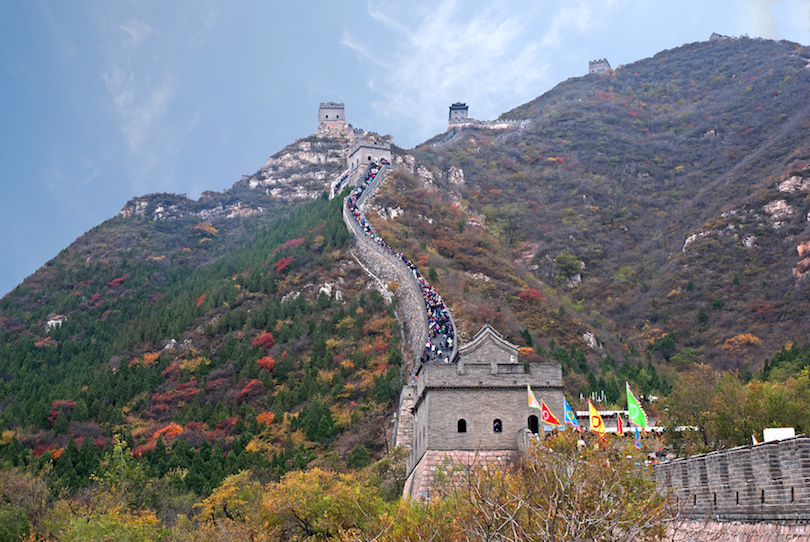
As it lies just an hour and a half to the northeast of Beijing, Juyongguan has long played an important role in the defense of the nation’s capital. In Juyong Pass Fort, it boasts one of the Great Wall’s most impressive forts. Exhibiting wonderful architecture with some features dating back to the Ming Dynasty, the fort occupies a prominent position in the Guangou Valley – one of the most critical access points to Beijing.
Despite its air of impenetrability, the Juyongguan section of the wall was actually breached by Genghis Khan in both 1211 and 1213. As it is the closest section of the wall to Beijing, Juyongguan is a very popular draw among tourists, who come to hike along the top of it, visit its fabulous fort, and take snaps of the marvelous scenery.
Lying just a short distance away are the Dingling Tombs – the only Ming Dynasty imperial mausoleum to be opened – and its museum and underground palace are well worth visiting if you’re in the area.
7. Gubeikou [SEE MAP]
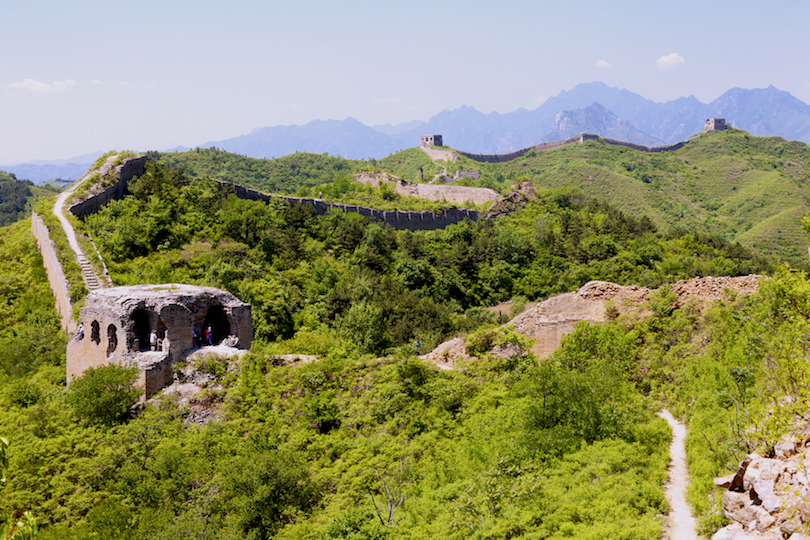
Located around two hour’s drive from Beijing, Gubeikou is one of the wildest and most rewarding parts of the Great Wall to explore. Most of it is quite unrestored, with decaying battlements and crumbling ruins wherever you look. Strategically located along the back of the Yan Mountains, Gubeikou guarded an important pass to Beijing and remarkably saw over 130 battles take place along its wall.
It has a number of interesting monuments for you to check out, such as General Tower and 24-Eye Tower. Impressively enough, no renovations or constructions have taken place here since 1567. While it is not as popular as other parts of the Great Wall, Gubeikou is ideal if you’re looking for a quiet getaway; it has lots of scenic hikes and interesting historical attractions on offer.
6. Simatai [SEE MAP]
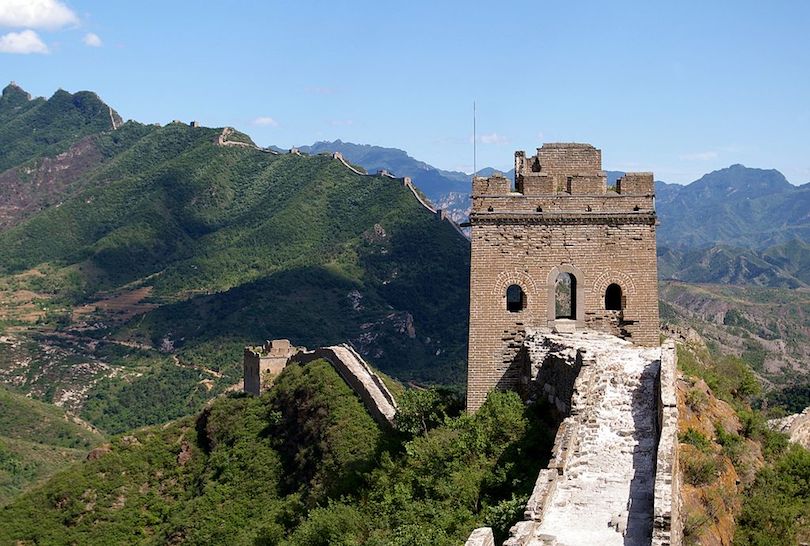
Weaving its way along the rolling ridgeline of the Yan Mountains, the Simatai section of the Great Wall is renowned for the steep drops that plunge away to either side of it. It’s one of the only parts that you can see lit up at night. Hiking along the top of it makes for an exhilarating experience as it feels like you’re walking in the air. One part, the Sky Bridge, is only 40 centimeters wide.
Strung out along the wall are a series of watchtowers, with some of them lying just 50 meters apart. From these, you can enjoy some simply stupendous views. Besides hiking along the wall, visitors can also go zip-lining and take a boat trip on the nearby reservoir up to the East Tower. One of the most memorable things to do at Simatai is to take a nighttime stroll and amble peacefully along the Great Wall of China, which is stunningly lit up against the night sky.
5. Huanghuacheng [SEE MAP]
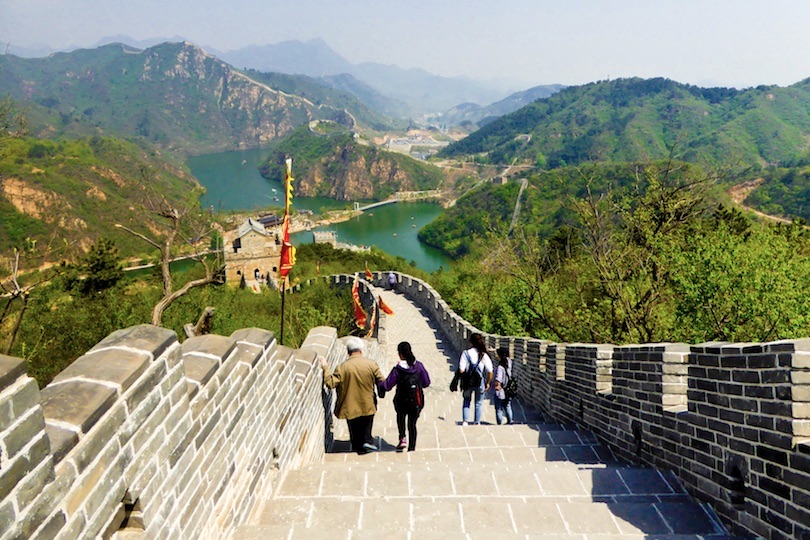
Officially known as the ‘Lakeside Great Wall,’ Huanghuacheng is the only section to be built alongside a body of water, and some of it is actually immersed in the lake that lies at its foot. The beautiful blue Haoming Lake stands out delightfully against the forest-coated mountains that lie all around it, and the Great Wall meandering across the landscape only completes the perfect scene.
Due to the challenging terrain, this section of the wall took 180 years to complete, and much of it has not been restored since 1592. Named after the lovely little yellow wildflowers that dot the mountains around it in summer, Huanghuacheng is a tranquil part of the wall, with few visitors. As such, hiking here amid the beautiful scenery with barely another soul in sight is an amazing experience, and taking a boat ride on the lake to see the wall from below is simply a must.
4. Jiankou [SEE MAP]
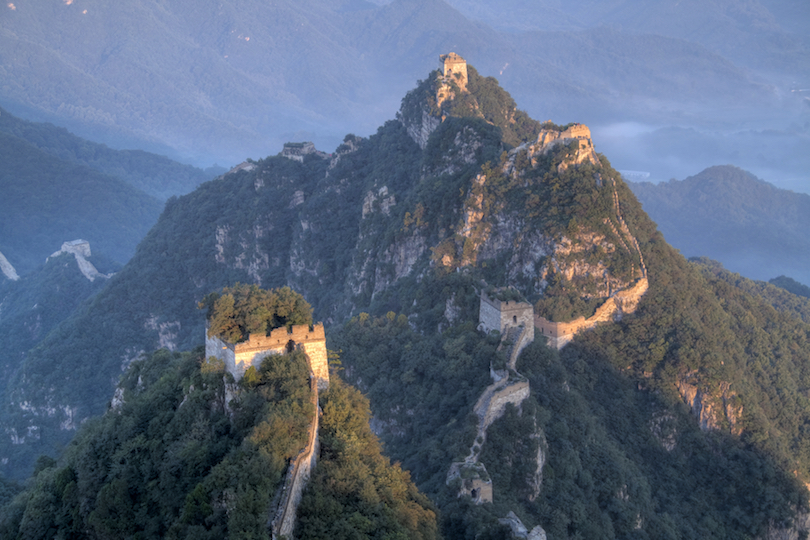
Located some 70 kilometers to the north of Beijing, Jiankou is the wildest, most dangerous, and therefore most exhilarating part of the Great Wall to explore. Completed all the way back in 1368, the wall hasn’t been restored since. Much of it lies in disrepair, with plants, flowers, and trees found growing up from its crumbling bricks.
Jiankou is home to some of the steepest parts of the wall, with ‘Upward Flying Eagle’ and ‘Heavenly Ladder’ being particularly hair-raising to navigate. The mountain scenery on show is really is out of this world. While hiking along this wild yet breathtakingly beautiful part of the wall, many people choose to camp on its battlements. Another star attraction is the ‘Beijing Knot,’ which is the point where three different sections of the Great Wall of China come together.
3. Badaling [SEE MAP]
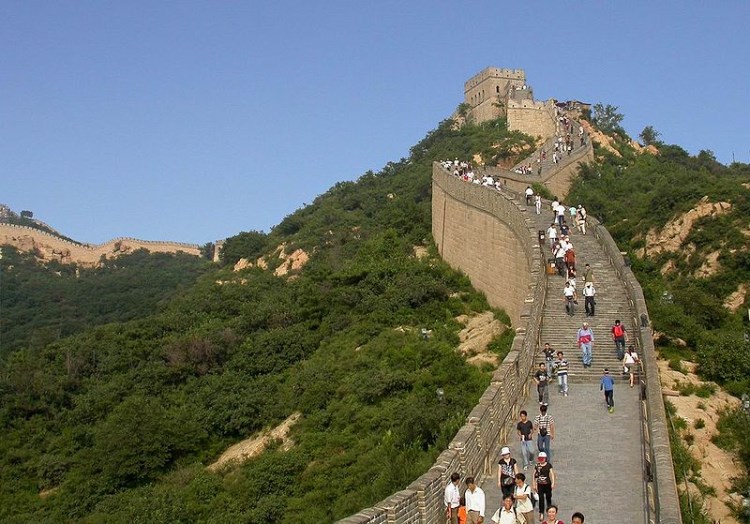
Built in 1504, Badaling is one of the most well-restored parts of the Great Wall, and its proximity to Beijing makes it the most popular section to visit amongst tourists. As such, it gets very crowded and is undoubtedly the most touristy part of the wall by far, with lots of shops, restaurants, and even cable cars on offer.
Badaling still has its charms, however, and over the years, it has been visited by everyone from President Nixon to Queen Elizabeth II. Very pleasant to stroll along, its towering walls look out over some gorgeous scenery, with steep mountain slopes tumbling away to either side of it. For its ease of access and wealth of facilities and photo opportunities, Badaling is well worth visiting if you don’t have time to venture further afield.
2. Jinshanling [SEE MAP]
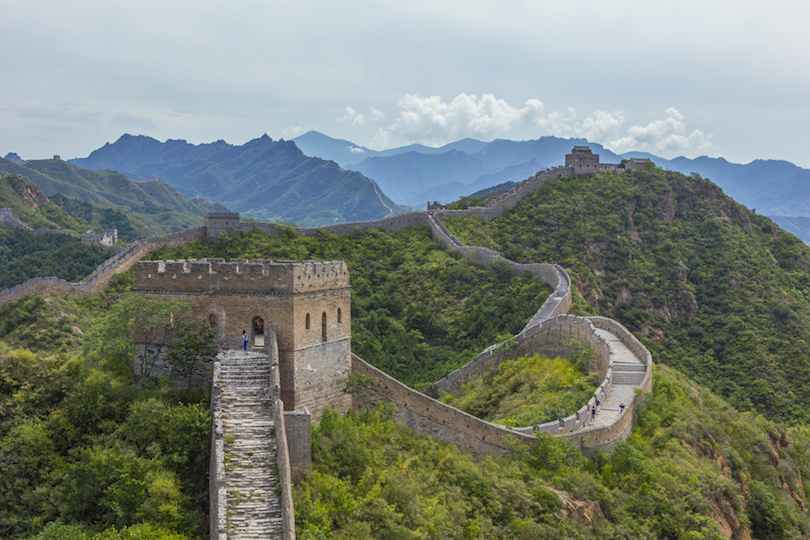
As it is renowned for being one of the most beautiful sections of the wall, Jinshanling has long been a popular draw among hikers, who come to enjoy its pristine nature and stunning views. Located some 130 kilometers away from Beijing in Hebei province, the Jinshanling section of the Great Wall is wild in places and restored in others; this variety is, in part, what makes it so brilliant to hike.
Interspersed along its 10.5 kilometers are 67 watchtowers for you to check out; these feature a wide variety of different architectural styles. It usually takes around seven hours to hike from Jinshanling to Gubeikou or vice versa. The views of the Great Wall snaking its way off into the distance across mountain ridges, passes, and valleys is simply mesmerizing.
1. Mutianyu [SEE MAP]
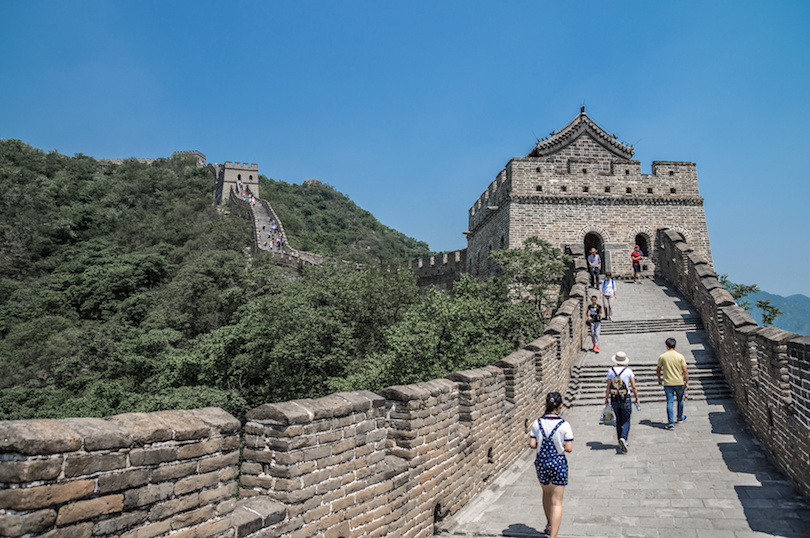
Despite its proximity to Beijing and its wealth of excellent views, Mutianyu is much less crowded than Badaling. As such, it is one of the most popular sections with foreign tourists. Surrounded on both sides by lush greenery, Mutianyu certainly makes for a fine sight as it cuts its way across the mountain ridges, with lots of watchtowers and fortresses dotted along the route.
To access the wall, visitors can either hike or take a cable car up to its battlements, and there is even a fun toboggan ride you can take to get down again. While it is still quite touristy in comparison with many other more remote sections of the wall, from time to time, you can still find yourself hiking along Mutianyu with barely another soul around. Boasting the longest, fully-restored section of the Great Wall of China, Mutianyu is a great place to start exploring all that this magnificent monument has to offer up.
Share this post:
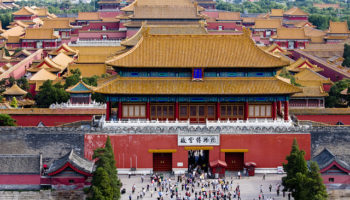
10 Top Tourist Attractions in Beijing
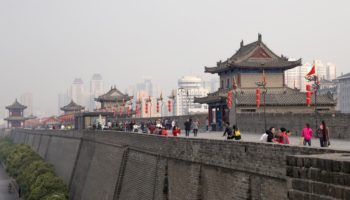
12 Best Things to Do in Xi’an, China
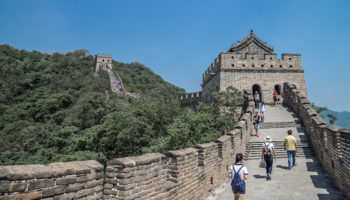
9 Best Day Trips from Beijing
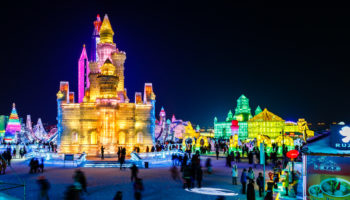
10 Most Amazing Destinations in North China
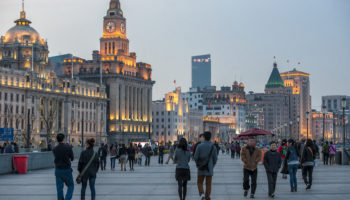
10 Top Tourist Attractions in Shanghai

9 Most Beautiful Regions in China

15 Best Cities to Visit in China

9 Best Things to Do in Lhasa, Tibet

17 Top Tourist Attractions in Hong Kong
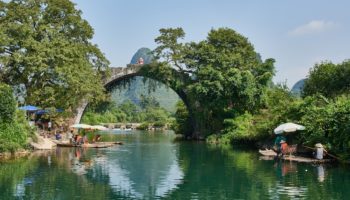

10 Best Things to Do in Yangshuo, China
Reader interactions, leave a reply cancel reply.
Your email address will not be published. Required fields are marked *
This site uses Akismet to reduce spam. Learn how your comment data is processed .
National Geographic content straight to your inbox—sign up for our popular newsletters here
- WORLD HERITAGE
See China’s Iconic Great Wall From Above
This is one of the world’s greatest feats of engineering.
China’s iconic Great Wall, actually a network of fortifications rather than a single structure, is the product of countless labors over a period of some two thousand years. Qin Shi Huang took the remnants of truly ancient fortifications, walls, and earthworks begun in the fifth century B.C. and linked them into a unified wall circa 220 B.C. as part of a massive project to protect China against marauding barbarians from the north.
By the time construction on most of the stone-and-brick Great Wall, with its turrets and watchtowers, was completed during the Ming dynasty (1368-1644) the chang cheng had become the world’s largest human-made object.
A recent government mapping project revealed that the entire Great Wall structure spans some 5,500 miles (8,850 kilometers) from the Korean border west into the Gobi desert. Of that total 3,889 miles (6,259 kilometers) were actual wall, while 223 miles (359 kilometers) were trenches and (1,387 miles) 2,232 kilometers were natural defensive barriers, like rivers or steep hills, incorporated into the system.
Though new sections of the wall have recently been uncovered, several sections of the structure have vanished during the past half century or so. Mao Zedong himself encouraged destruction of parts of the wall and reuse of its materials in the 1950s, and rural farmers still make use of the wall’s earth and stone for practical purposes.
Some 50 percent of the original ancient structure has already disappeared, and perhaps another 30 percent lies crumbling into ruins—even as Chinese and international organizations struggle to preserve what remains of this unique treasure.
21 of China's Most Spectacular UNESCO Sites

How to Get There
tourists explore the wall from Beijing. The most popular section (Badaling) is 42 miles (70 kilometers) from the city. This section boasts impressive views, and with crowds come all the modern trappings of development. Those seeking less popular or unrestored sections of the wall have many suitable choices within easy driving distance of Beijing.
The wall has endured centuries of seasons and remains ready to host visitors year round. The Beijing region has icy winters, but the hardy will find far fewer crowds than during the peak summer seasons. Autumn is often delightful near Beijing with mild weather (43° to 64°F/6° to 18°C) and reduced tourist crowds. Wind and dust can be common in springtime. China is a nation of festivals, so consider timing a visit to coincide with a celebration in the shadows of the wall.
- Nat Geo Expeditions
How to Visit
As is appropriate for a monument so massive, there are many ways to visit the wall. Some visitors aspire to admire the views from popular tourist sections, pose for pictures, walk the wall, and take advantage of amenities from restaurants and shops to cable car rides. Others choose to explore rugged sections of the structure on extended hikes and climbs of unrestored “wild wall” sections, though these can be dangerous and are often located in rural areas well off the typical tourist path.
FREE BONUS ISSUE
Related topics.
- WORLD HERITAGE SITES
- ENGINEERING
- ANCIENT CIVILIZATIONS
You May Also Like

See these 6 architectural wonders before they disappear

20 of the coolest travel adventures for 2024

Carthage was Rome’s greatest rival. Go see its side of the story.

This ancient marvel rivaled Rome’s intricate network of roads

See the summer solstice from a Roman emperor’s party cave
- Environment
- Perpetual Planet
History & Culture
- History & Culture
- History Magazine
- Mind, Body, Wonder
- Paid Content
- Terms of Use
- Privacy Policy
- Your US State Privacy Rights
- Children's Online Privacy Policy
- Interest-Based Ads
- About Nielsen Measurement
- Do Not Sell or Share My Personal Information
- Nat Geo Home
- Attend a Live Event
- Book a Trip
- Inspire Your Kids
- Shop Nat Geo
- Visit the D.C. Museum
- Learn About Our Impact
- Support Our Mission
- Advertise With Us
- Customer Service
- Renew Subscription
- Manage Your Subscription
- Work at Nat Geo
- Sign Up for Our Newsletters
- Contribute to Protect the Planet
Copyright © 1996-2015 National Geographic Society Copyright © 2015-2024 National Geographic Partners, LLC. All rights reserved
- Best Tourist Attractions Along the Great Wall of China
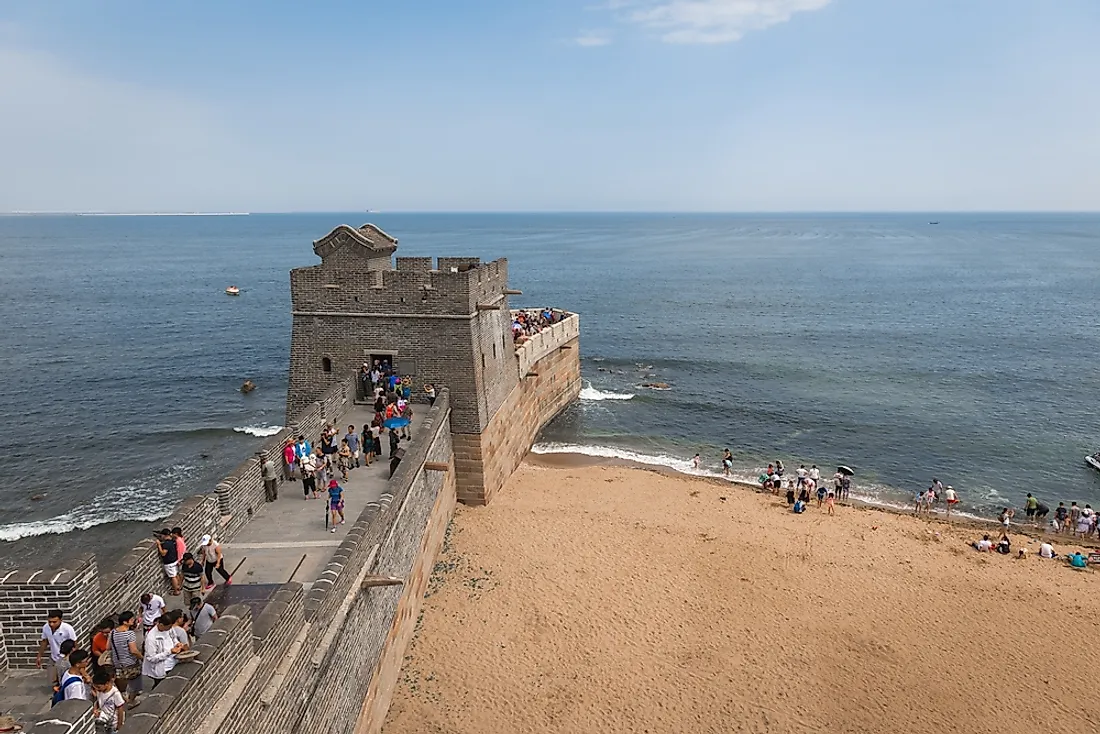
The China National Tourism Administration has rated several sites along the Great Wall of China as AAAAA tourist attractions. The AAAAA tourist attractions are also known as Scenic areas. They are China’s best-maintained and most important tourist sceneries. The China National Tourist Administration has given these areas high level-rating categories. In the beginning, 66 areas gained approval out of the 106 areas nominated. Since then, subsequent areas have made it to the list of China’s best attractions. As of today, China has 249 official AAAAA tourist attractions.
Some of the best tourist attractions along the Great Wall of China include Badaling Great Wall, Shanhai Pass, Baishi Mountain, and Yanmen Pass Scenic Area. Other AAAAA-rated tourist attractions in China include Mount Pan in Tianjin, Guwenhua Jie in Tianjin, Olympic Green in Beijing, and Baiyang Lake in Hebei among others.
4. Badaling Great Wall
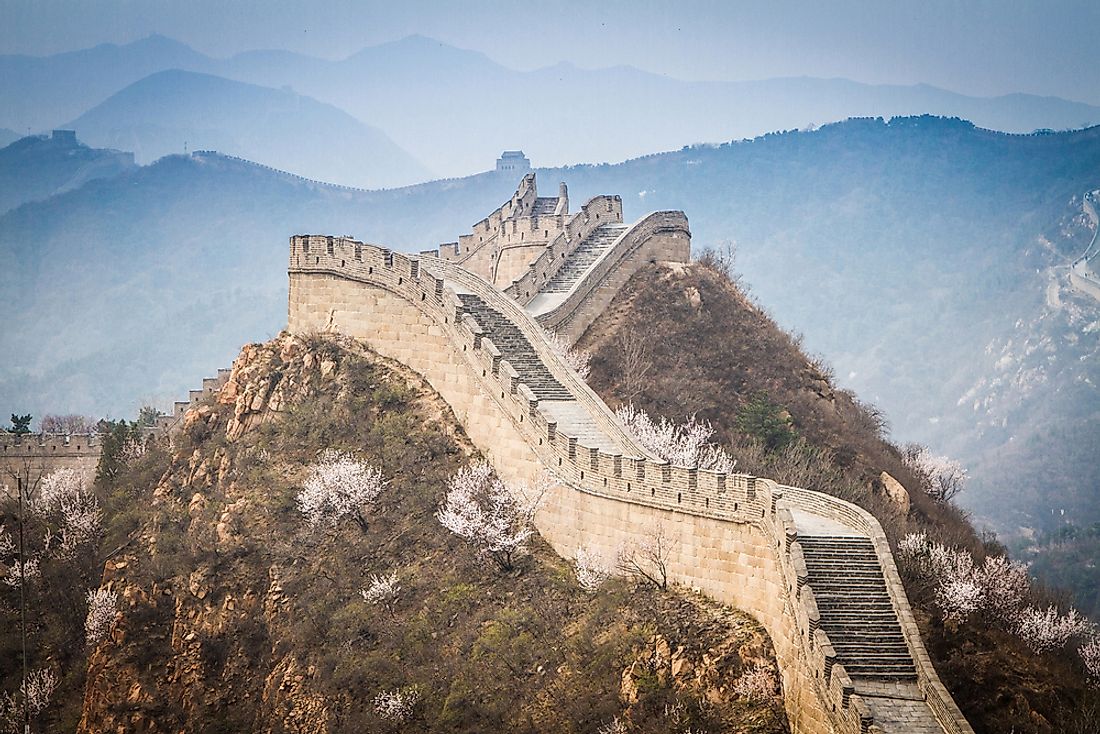
Badaling is the most visited site on the Great Wall of China. It lies 80 km northwest of the urban Beijing city in Yanqing District. Badaling wall was built in 1504 during the Ming Dynasty together with a military outpost showing how the area is strategically important. The wall came up to act as a commanding and strategic area for protecting the Juyongguan Pass on the south and Beijing city. Belbao is the highest point on the Badaling Great Wall rising to 1,015 meters above sea level.
The Badaling was the first area of the Great Wall of China to be opened for tourists in 1957. The area has undergone great development including construction of restaurants, cable cars, and hotels. The Badaling Expressway completed recently connects central Beijing and Badaling.
US President Richard Nixon and his wife visited Badaling wall during his historic journey to China on February 24, 1972. Other leaders who have made trips to Badaling include Ronald Reagan, Mikhail Gorbachev, and Margaret Thatcher. Additionally, the expressway and Badaling were the finishing circuit during the Urban Road Cycling Course in the 2008 Summer Olympics.
3. Yanmen Pass Scenic Area
The Yanmen Pass also goes by the name Yanmennguan or Xixingguan in the Chinese language. It is a mountain pass with three fortified gates. In ancient China, the area served as a checkpoint, controlling movements between the valleys of Eurasian Steppe and central Shanxi. It was here that many important battles that stretched into the Second World War took place. Today, the pass is an AAAAA-rated tourist attraction on the Great Wall of China.
Geographically, Yanmen pass is in the mountains of Yanmen or Gouzhu between Hutuo River and Sanggan River basins. The Yanmenguan village lies 20 km from Shangguan county seat and 180 km northeast of the provincial capital Taiyuan.
Yanmen Pass has fortifications that protect the inner line of the China Great Wall together with Pianguan and Ningwu passes. In the past Yanmen was regarded the first among the nine passes under heaven. It has three gates, Dili, Central ate, and Tianxian gate, which are open to the people.
The Zhenbian Hall is a temple to Zhao and Li Mu general. Since 1856, local Buddhists have used the temple when Monk Shan Quan started worshipping in it. Beside the Dili gate, there is a temple to Guan Yu, the Chinese god of war.
The Yanmen Pass also has the remains of Guangwu, the former area county leader. The Han-era tombs are among his remains measuring 2-10 meters high. The Japanese archaeologists excavated them in early 20 th century and the Chinese scientists studied them in the 1980s.
2. Shanhai Pass
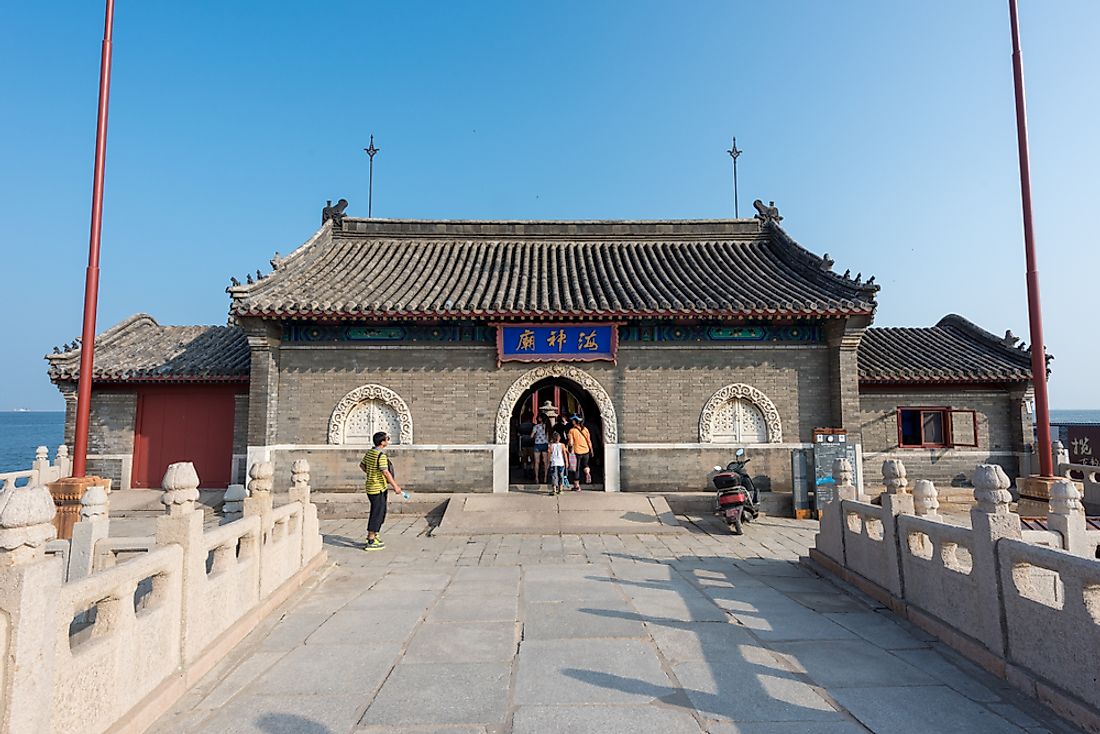
The Shanhai Pass also goes by the name Shanhaiguan in Chinese language. It lies in Shanhaiguan District, Qinhuangdao, in the province of Hebei. Ming general Xu Da built the pass in 1381. In 1961, the pass became a National Cultural Site of China. The pass is located 300 km east of Beijing. The Jingshen Expressway links the pass to Beijing.
Historically, the pass acted as a frontline defense against Manchuria ethnic groups like the Manchus, Jurchen, and Khitan. Ming general Qi Jinguang fortified and constructed a city for military around the pass plus other cities, thus making it a heavily fortified pass in China. It is the best passes in the Great Wall of China today.
The Shanhai Pass is square-shaped with a 4 km perimeter. Its walls are 14 meters high and 7 meters thick. The north, south, and east sides of the wall are enclosed by a deep and wide moat with drawbridges above it. In addition, there is a tall bell tower standing in the middle of the pass.
The four sides of the Shanhai Pass had a gate and gate men at one particular time. The Weiyuan Gate lies in the north, Wangyang Gate on the south, Zhendong Gate on the east, and Ying’en Gate on the west. The Zhendong Gate is the only one standing currently due to lack of repairs. Zhendong Gate due to its position served important activities as it faces Beijing.
1. Baishi Mountain
The Baishi Mountain is also known as Baishishan in Chinese. It lies in Laiyuan County, in the province of Hebei in China. It has the highest peak of 6877 feet elevation and its main ridge extends over 22,966 feet. Baishi Mountain also lies 200 km southwest of Beijing and it forms the northern end of Taihang Chain. Around the Mountain’s foothill, lie the remains of the Great Wall.
The white marble makes parts of the mountain and that is where it derives its name. Baishi Mountain’s top is made of dolomite covering 20 km 2 . The National Tourism Administration of China established the Baishi Scenic Area in 2004. In September 2006, the area was converted to Baishi National Geological Park after being named a world geological park by UNESCO. Additionally, in early 2017, the China National Tourism Administration rated it as an AAAAA-level tourist attraction.
The mountain is prominent for its appearance during overcast days. During these days, the mountain’s peaks appear to be jutting out from low-lying mist and clouds. The Baishi Mountain has had China’s widest, longest, and highest glass skywalk since September 2014. The skywalk stretches to 95 meters at an elevation of 1,900 meters. In August 2015, the second skywalk was opened with an elevation of 1,600 meters.
More in Travel

13 Most Underrated Towns In New York To Take A Trip To

Tales in Transit: The Twists & Turns of World Travel

13 Most Underrated Towns In Massachusetts To Take A Trip To

9 Most Underrated Towns In Washington To Take A Trip To

Riding The Rails Across Europe: A Haphazard Adventure

An American's Guide for the Camino de Santiago

13 Most Underrated Towns In Upstate New York To Take A Trip To

Explore The Most Charming Spots To Visit Around Lake Constance
- History Classics
- Your Profile
- Find History on Facebook (Opens in a new window)
- Find History on Twitter (Opens in a new window)
- Find History on YouTube (Opens in a new window)
- Find History on Instagram (Opens in a new window)
- Find History on TikTok (Opens in a new window)
- This Day In History
- History Podcasts
- History Vault
Great Wall of China
By: History.com Editors
Updated: April 18, 2024 | Original: August 24, 2010

The Great Wall of China is an ancient series of walls and fortifications, totaling more than 13,000 miles in length, located in northern China. Perhaps the most recognizable symbol of China and its long and vivid history, the Great Wall was originally conceived by Emperor Qin Shi Huang in the third century B.C. as a means of preventing incursions from barbarian nomads. The best-known and best-preserved section of the Great Wall was built in the 14th through 17th centuries A.D., during the Ming dynasty. Though the Great Wall never effectively prevented invaders from entering China, it came to function as a powerful symbol of Chinese civilization’s enduring strength.
Qin Dynasty Construction
Though the beginning of the Great Wall of China can be traced to the fifth century B.C., many of the fortifications included in the wall date from hundreds of years earlier, when China was divided into a number of individual kingdoms during the so-called Warring States Period.
Around 220 B.C., Qin Shi Huang, the first emperor of a unified China under the Qin Dynasty , ordered that earlier fortifications between states be removed and a number of existing walls along the northern border be joined into a single system that would extend for more than 10,000 li (a li is about one-third of a mile) and protect China against attacks from the north.
Construction of the “Wan Li Chang Cheng,” or 10,000-Li-Long Wall, was one of the most ambitious building projects ever undertaken by any civilization. The famous Chinese general Meng Tian initially directed the project, and was said to have used a massive army of soldiers, convicts and commoners as workers.
Made mostly of earth and stone, the wall stretched from the China Sea port of Shanhaiguan over 3,000 miles west into Gansu province. In some strategic areas, sections of the wall overlapped for maximum security (including the Badaling stretch, north of Beijing, that was later restored during the Ming Dynasty ).
From a base of 15 to 50 feet, the Great Wall rose some 15-30 feet high and was topped by ramparts 12 feet or higher; guard towers were distributed at intervals along it.
Did you know? When Emperor Qin Shi Huang ordered construction of the Great Wall around 221 B.C., the labor force that built the wall was made up largely of soldiers and convicts. It is said that as many as 400,000 people died during the wall's construction; many of these workers were buried within the wall itself.
Great Wall of China Through the Centuries
With the death of Qin Shi Huang and the fall of the Qin Dynasty, much of the Great Wall fell into disrepair. After the fall of the later Han Dynasty , a series of frontier tribes seized control in northern China. The most powerful of these was the Northern Wei Dynasty, which repaired and extended the existing wall to defend against attacks from other tribes.
The Bei Qi kingdom (550–577) built or repaired more than 900 miles of wall, and the short-lived but effective Sui Dynasty (581–618) repaired and extended the Great Wall of China a number of times.
With the fall of the Sui and the rise of the Tang Dynasty , the Great Wall lost its importance as a fortification, as China had defeated the Tujue tribe to the north and expanded past the original frontier protected by the wall.
During the Song Dynasty, the Chinese were forced to withdraw under threat from the Liao and Jin peoples to the north, who took over many areas on both sides of the Great Wall. The powerful Yuan (Mongol) Dynasty (circa 1271-1368), established by Genghis Khan , eventually controlled all of China, parts of Asia and sections of Europe.
Though the Great Wall held little importance for the Mongols as a military fortification, soldiers were assigned to man the wall in order to protect merchants and caravans traveling along the lucrative Silk Road trade routes established during this period.
Wall Building During the Ming Dynasty
Despite its long history, the Great Wall of China as it is exists today was constructed mainly during the mighty Ming Dynasty (1368-1644).
Like the Mongols, the early Ming rulers had little interest in building border fortifications, and wall building was limited before the late 15th century. In 1421, the Ming emperor Yongle proclaimed China’s new capital, Beijing, on the site of the former Mongol city of Dadu.
Under the strong hand of the Ming rulers, Chinese culture flourished, and the period saw an immense amount of construction in addition to the Great Wall, including bridges, temples and pagodas.
Construction on the most extensive and best-preserved section of the Great Wall began around 1474. After an initial phase of territorial expansion, Ming rulers took a largely defensive stance, and their reformation and extension of the Great Wall was key to this strategy.
The Ming wall extended from the Yalu River in Liaoning Province to the eastern bank of the Taolai River in Gansu Province, and winded its way from east to west through today’s Liaoning, Hebei, Tianjin, Beijing, Inner Mongolia, Shanxi, Shaanxi, Ningxia and Gansu.
Starting west of Juyong Pass, the Great Wall was split into south and north lines, respectively named the Inner and Outer Walls. Strategic “passes” (i.e., fortresses) and gates were placed along the wall; the Juyong, Daoma and Zijing passes, closest to Beijing, were named the Three Inner Passes, while further west were Yanmen, Ningwu and Piantou, the Three Outer Passes.
All six passes were heavily garrisoned during the Ming period and considered vital to the defense of the capital.
Significance of the Great Wall of China
In the mid-17th century, the Manchus from central and southern Manchuria broke through the Great Wall and encroached on Beijing, eventually forcing the fall of the Ming Dynasty and beginning of the Qing Dynasty.
Between the 18th and 20th centuries, the Great Wall emerged as the most common emblem of China for the Western world, and a symbol both physical—as a manifestation of Chinese strength—and a psychological representation of the barrier maintained by the Chinese state to repel foreign influences and exert control over its citizens.
Today, the Great Wall is generally recognized as one of the most impressive architectural feats in human history. In 1987, UNESCO designated the Great Wall a World Heritage site, and a popular claim emerged in the 20th century that it is the only manmade structure visible from space ( NASA has since refuted this claim ).
Over the years, roadways have been cut through the wall in various points, and many sections have deteriorated after centuries of neglect. The best-known section of the Great Wall of China—Badaling, located 43 miles (70 km) northwest of Beijing—was rebuilt in the late 1950s, and attracts thousands of national and foreign tourists every day.

Sign up for Inside History
Get HISTORY’s most fascinating stories delivered to your inbox three times a week.
By submitting your information, you agree to receive emails from HISTORY and A+E Networks. You can opt out at any time. You must be 16 years or older and a resident of the United States.
More details : Privacy Notice | Terms of Use | Contact Us
- Travel Tips
- How to Visit It
- Which Section to Visit
- 6 Best Places to See
- 9 Unusual Things to Do
- Best Time to Visit
- How much does it cost to visit it?
- How to Travel There from Beijing
- How to Travel There from Beijing Airport
- How to Travel There from Shanghai
- How to Travel There from Hong Kong
- 10 Guidelines in Winter
- How to Camp on It
- Why should I visit it? - Top 10 Reasons
- Hiking & Walking
- Construction
Why should I visit the Great Wall of China? - Top 10 Reasons
Reason 1: the great wall is china’s no. 1 tourist site..
The Great Wall of China is the hottest attraction in China. A tour to China without Great Wall is not complete.
Reason 2: The Great Wall of China is the longest man-made construction in the world.
It has a total length of 21,196 kilometers (13,170 miles). There was once a rumor that the Great Wall can be seen from space. Although it was proved to be wrong by the scientists, we cannot deny the massive scale of the Great Wall.
Reason 3: Learn Chinese History
The Great Wall has a long history of more than 2,700 years. From the earliest construction in the Spring and Autumn Period (770 – 476 BC) to the final construction in 1878 during the late Qing Dynasty (1644 - 1911 AD), many dynaties successively constructed it throughout the 2,500 years. Actually, its construction ran through alomost the entire Chinese ancient history. You can especially learn the history of Qin (221 - 207 BC), Han (202 BC - 220 AD) and Ming (1368 - 1644 AD), when Great Wall was extensively built. This reason to visit Great Wall lies in that it can offer you some knowledge of Chinese history and different nationalities on two sides of the Wall.
Reason 4: Enjoy the Terrific Natural Scenery
Most sites were built along mountain ridges in suburba areas, which have fantastic natural scenery and fresh air.
Reason 5: Test your courage and physical strength.
Badaling and Mutianyu are the preferred choices for most tourists, taking at least 2 hours to hike. In addition, there are many wild sections, such as Jiankou . Climbing these sections is a great challenge for braveness and physical strength as it is quite adventurous and energy-consuming.
Reason 6: Take Great Photos
Reason 7: the great wall is favored by world leaders and celebrities..
Many world leaders and celebrities have journeyed the Great Wall of China, such as former US president Obama, Queen Elizabeth II of the UK, Tom Hiddleston, and Tom Cruise.
Reason 8: Learn Military of Ancient China
The Great Wall is not an ordinary wall; the wall, together with watch towers, beacon towers and passes, constitutes a complete defensive system against the invasion of the northern nomadic people.
Reason 9: Know more about Chinese people and Chinese culture.
Great Wall is the symbol of China. It was included in Chinese national anthem and printed on the first and fourth sets of RMB. In China, there are many sayings relating to Great Wall, and the most famous is “he who does not reach the Great Wall is not a true man”. Only having been to the Great Wall can you better understand Chinese and the diligence and unity of the Chinese nation.
Reason 10: One of the New Seven Wonders of the World
Among the new seven wonders of the world, the Great Wall of China ranks first.
How to Visit the Great Wall of China
Which Section of Great Wall of China to Visit
Best Time to Visit Great Wall of China
How much does it cost to visit the Great Wall of China?
10 Insider Tips for Great Wall Travel - Dos and Don’ts
10 Guidelines for Travel to Great Wall of China in Winter
How to Camp on the Great Wall of China
Winter is here! Check out the winter wonderlands at these 5 amazing winter destinations in Montana
- Travel Destinations
Why Is The Great Wall Of China A Tourist Attraction
Published: November 7, 2023
Modified: December 28, 2023
by Cleopatra Fleischman
- Arts & Culture
- Plan Your Trip
Introduction
The Great Wall of China, one of the most iconic and impressive structures ever built, stands as a testament to the ingenuity and ambition of the ancient Chinese civilization. Stretching over 13,000 miles, this architectural marvel traverses diverse terrains, from rugged mountains to vast plains, and holds immense historical and cultural significance.
The Great Wall of China was originally constructed as a defensive fortification to protect China from nomadic tribes and potential invasions. Its construction began as early as the 7th century BC and continued for centuries under different dynasties. The wall consists of various sections, each built during different time periods and using different materials.
Today, the Great Wall of China has become a major tourist attraction, drawing millions of visitors from around the world. Its sheer size, historical significance, and breathtaking views have made it an enduring symbol of Chinese civilization and a UNESCO World Heritage site.
Aside from its historical and cultural significance, the Great Wall of China offers visitors a chance to experience the architectural wonders of ancient China. From the imposing watchtowers to the steep steps and winding paths, every section of the wall showcases the remarkable engineering skills of the people who built it.
This article will delve into the historical background, architectural features, and significance of the Great Wall of China. We will also explore the factors contributing to its popularity as a tourist attraction, the challenges it faces, and the preservation efforts being undertaken to safeguard this magnificent wonder.
Historical Background of the Great Wall of China
The origins of the Great Wall of China can be traced back to the Warring States Period (476-221 BC) when various Chinese states built walls to defend their territories. However, it was during the Qin Dynasty (221-206 BC) that the first unified and continuous wall was constructed. This early version of the wall served as a defense against attacks from the northern nomadic tribes.
Over the centuries, different dynasties, including the Han, Sui, and Ming, contributed to the construction, expansion, and reinforcement of the wall. The Han Dynasty (206 BC-220 AD) extended the wall further west to protect important trade routes, while the Sui Dynasty (581-618 AD) repaired and reinforced existing sections. However, it was the Ming Dynasty (1368-1644 AD) that extensively rebuilt and expanded the Great Wall to its current form.
During the Ming Dynasty, the Great Wall reached its peak as a defensive structure. It was constructed using bricks, stones, and rammed earth, with watchtowers strategically placed along its length. These watchtowers provided lookout points and fortified positions for soldiers.
While the primary purpose of the Great Wall was defense against invaders, it also served as a symbolic display of imperial power and national unity. The wall symbolized the strength and greatness of the Chinese empire, reinforcing the metaphorical notion that China was an impregnable fortress.
Despite the incredible scale and effort put into the construction of the Great Wall, it was not entirely effective in keeping out invaders. In fact, numerous breaches and invasions occurred over the centuries. However, the wall served as a deterrent and made it more challenging for invaders to breach China’s borders.
Today, the Great Wall of China stands as a testament to the rich history and perseverance of the Chinese people. It reflects their determination to protect their land and preserve their cultural identity amidst external threats. It also stands as a reminder of the incredible engineering achievements of ancient civilizations, captivating visitors with its historical significance and architectural grandeur.
Architectural Features of the Great Wall of China
The Great Wall of China is a remarkable testament to the architectural brilliance of ancient China. Its construction, spanning centuries and different dynasties, showcases a variety of architectural features and techniques. Here are some notable features of the Great Wall:
- Materials: The construction of the Great Wall utilized a variety of materials, depending on the availability in each region. The most common materials include stones, bricks, and rammed earth. In some sections, layers of tamped earth, reeds, and wooden frames were used to strengthen the structure.
- Watchtowers: Distributed along the length of the wall, watchtowers served as strategic strongholds and observation posts. These towers allowed soldiers to survey the surrounding areas, spot potential threats, and communicate using smoke signals or lanterns. The design of the watchtowers varied across different sections of the wall and often incorporated intricate features and decorative elements.
- Fortresses: In addition to the watchtowers, the Great Wall also housed numerous fortresses at key points. These fortresses provided additional defense and acted as military bases. They were equipped with barracks, stables, wells, and other necessary facilities to sustain soldiers stationed along the wall.
- Gateways and Passes: The Great Wall featured gateways and passes at strategic locations that allowed for controlled access and movement. These gateways were fortified with additional defensive structures, such as barbicans and drawbridges, to enhance security.
- Steep Grades and Steps: Due to the varying terrains it crossed, the Great Wall often traverses steep mountain slopes. To ensure stability and ease of movement, sections of the wall employ steps or inclines. The steps are of varying heights and widths, making the ascent challenging but manageable for both soldiers and visitors.
The architectural features of the Great Wall of China not only served defensive purposes but also exhibited the artistic and aesthetic sensibilities of the builders. The integration of functional elements with decorative elements, such as intricate carvings, ornamental patterns, and inscriptions, showcases the skill and craftsmanship of ancient Chinese architects.
Exploring the Great Wall allows visitors to appreciate the remarkable engineering and architectural marvel that has stood the test of time. From the imposing walls to the watchtowers and fortresses, each section offers a unique glimpse into ancient China’s ingenuity and dedication to protecting its borders.
Significance and Symbolism of the Great Wall of China
The Great Wall of China holds immense historical, cultural, and symbolic significance for the Chinese people. It is not merely a physical barrier but a powerful symbol of unity, national identity, and an enduring testament to human perseverance. Here are some of the key aspects of its significance and symbolism:
- Defense and Protection: The primary purpose of the Great Wall was to defend China against invasions by nomadic tribes from the north. As a result, it played a crucial role in safeguarding the country’s territorial integrity and sovereignty. The wall represented a physical and psychological barrier that deterred potential invaders, fostering a sense of security among the Chinese population.
- Chinese Civilizational Achievement: The construction of the Great Wall exemplifies the remarkable engineering and architectural prowess of ancient China. It stands as a testament to the country’s rich history and the ingenuity of its people. As an architectural marvel, the Great Wall showcases the technological advancements and the immense effort put into its construction, solidifying China’s position as a great civilization.
- Unity and National Identity: The Great Wall has served as a unifying symbol for the Chinese people throughout history. It has played a vital role in fostering a sense of national identity, pride, and resilience. The wall’s construction involved the collective effort and sacrifice of countless individuals, representing the strength that lies in unity and cooperation.
- Cultural Icon and Tourist Attraction: The Great Wall of China has transcended its original purpose and has become an iconic symbol of China. It is a source of inspiration for artists, writers, and poets who have praised its magnificence and grandeur. The wall’s historical and cultural significance attracts millions of tourists from around the world each year, eager to witness this extraordinary feat of human achievement.
- Metaphorical Representation: Beyond its physical presence, the Great Wall holds metaphorical significance. It represents the indomitable spirit and resilience of the Chinese people in the face of adversity. It symbolizes their determination to protect their homeland, preserve their cultural heritage, and withstand external challenges.
The Great Wall of China has left an indelible mark on Chinese history, culture, and national psyche. It continues to inspire awe and admiration, serving as a reminder of the remarkable achievements of the past and the enduring legacy of the Chinese civilization. Whether admired for its historical significance, architectural brilliance, or symbolic representation, the Great Wall remains an iconic symbol of pride, unity, and national heritage for the Chinese people.
Tourism and the Great Wall of China
The Great Wall of China has become one of the most popular tourist destinations in the world, attracting millions of visitors from all corners of the globe. Its historical significance, architectural splendor, and breathtaking views make it an irresistible attraction for travelers. Here are some key factors that contribute to the appeal of the Great Wall as a tourist destination:
- Historical and Cultural Significance: The Great Wall of China is steeped in history and culture. Visiting the wall allows tourists to immerse themselves in the rich heritage and ancient civilization of China. It provides a unique opportunity to learn about the country’s dynasties, conflicts, and the enduring spirit of its people.
- Architectural Marvel: The Great Wall’s monumental architecture and engineering brilliance captivate the imagination of visitors. Exploring its winding paths, climbing its steep steps, and marveling at the watchtowers reveal the skill and craftsmanship of ancient Chinese builders. The sheer scale and complexity of the wall leave tourists in awe of the human achievement it represents.
- Picturesque Landscapes: Stretching through diverse terrains, the Great Wall offers breathtaking and varied landscapes. From panoramic mountain views to sweeping vistas of lush valleys, each section of the wall provides a unique and picturesque experience. The beauty of the natural surroundings enhances the allure of the Great Wall as a tourist destination.
- Trekking and Hiking Opportunities: The Great Wall presents abundant trekking and hiking opportunities for adventure enthusiasts. Whether it’s a leisurely stroll along restored sections or a challenging hike across wild and rugged terrain, the wall offers unforgettable experiences for those seeking outdoor activities and a connection with nature.
- Cultural Exchange: The Great Wall serves as a bridge for cultural exchange. Visitors from different countries and backgrounds come together to explore its wonders, share stories, and learn from each other. The wall has become a meeting point for people from around the world, fostering an environment of cultural understanding and appreciation.
- Photographic Opportunities: The Great Wall offers countless opportunities for stunning photographs. From panoramic shots of the winding wall disappearing into the horizon to close-ups of ancient bricks and intricate watchtowers, the visual appeal of the Great Wall provides photographers with a wealth of subject matter to capture.
With its historical significance, architectural marvels, breathtaking landscapes, and cultural exchange opportunities, the Great Wall of China has firmly established itself as a must-visit destination for travelers. It offers a captivating experience that combines exploration, adventure, and a deep appreciation for the grandeur of Chinese history and culture.
Factors Contributing to the Great Wall’s Popularity as a Tourist Attraction
The Great Wall of China’s popularity as a tourist attraction can be attributed to a combination of factors that make it a unique and captivating destination. From its historical significance to its architectural grandeur, here are some key factors that contribute to the Great Wall’s popularity:
- Historical Significance: The Great Wall holds immense historical value, spanning over centuries and representing the rich legacy of Chinese civilization. It is renowned for its role in defending the nation and its cultural symbolism, making it a remarkable destination for history enthusiasts.
- Architectural Marvel: The Great Wall’s grand and intricate architecture is awe-inspiring to visitors. Its imposing watchtowers, steep steps, and fortified walls showcase the incredible engineering achievements of the ancient Chinese. Tourists are drawn to witness and marvel at the scale and craftsmanship of this monumental structure.
- UNESCO World Heritage Status: The Great Wall of China has been recognized as a UNESCO World Heritage site since 1987. This designation adds to its appeal, as it highlights the wall’s universal value and the need for its preservation. Tourists are often inclined to visit heritage sites of global importance.
- Scenic Beauty: The Great Wall traverses diverse landscapes, offering breathtaking views of mountains, valleys, and picturesque countryside. This natural beauty enhances the overall experience for visitors and makes it an ideal destination for photography and outdoor enthusiasts.
- Cultural Immersion: Visiting the Great Wall allows tourists to immerse themselves in Chinese culture and history. They can learn about the customs, traditions, and beliefs associated with the wall. Interacting with local communities and participating in cultural activities further enriches the experience.
- Accessibility and Infrastructure: The Great Wall’s popularity is also inherently linked to the accessibility and infrastructure available to tourists. Many sections of the wall, such as Badaling and Mutianyu, have been restored and developed with visitor facilities like cable cars, shops, and restaurants, making it easier and more comfortable for tourists to explore.
- Media Exposure: The Great Wall has received significant media exposure over the years, featuring prominently in films, documentaries, and travel shows. This exposure has helped to create awareness and generate interest among potential visitors, driving its popularity as a tourist attraction.
The combination of historical significance, architectural splendor, scenic beauty, cultural immersion, accessibility, and media exposure contribute to the Great Wall of China’s enduring popularity as a must-visit tourist attraction. Its universal appeal as an iconic symbol of Chinese history and culture continues to draw millions of visitors from around the world each year.
Challenges and Preservation Efforts for the Great Wall of China
Ensuring the long-term preservation of the Great Wall of China presents several challenges due to its immense size, age, and exposure to natural and human-related factors. Here are some of the significant challenges and the ongoing preservation efforts:
- Deterioration and Weathering: The Great Wall is over 2,000 years old and has faced extensive weathering and natural deterioration. Harsh weather conditions, including extreme temperatures, rainfall, and wind erosion, contribute to the degradation of the wall’s structural integrity.
- Tourism Impact: The high volume of tourists visiting the Great Wall can also pose challenges to its preservation. Foot traffic, littering, and unauthorized modifications can cause damage to the walls and surrounding areas. Preservation efforts must strike a balance between promoting tourism and protecting the wall.
- Illegal Construction and Quarrying: Illegal construction and quarrying activities near the Great Wall pose a threat to its preservation. Encroachments on its lands, unauthorized mining, and the extraction of materials from the wall can compromise its integrity and historical value.
- Lack of Funding: Preserving the Great Wall requires significant financial resources. However, limited funding presents a challenge to its maintenance, restoration, and research. Securing sustainable funding for preservation and conservation projects remains a continuous challenge.
- Fragmentation and Lost Sections: Over time, sections of the Great Wall have been lost due to neglect, natural disasters, and human activities. Fragmentation poses a challenge to preserving the wall’s integrity and historical continuity. Efforts are being made to locate and restore these lost sections.
- Conservation and Restoration: Preservation efforts involve conservation and restoration work to maintain and repair damaged sections of the wall. This includes stabilizing foundations, replacing missing or decayed bricks, and preventing further deterioration caused by weathering and human activities.
- Education and Awareness: Raising awareness about the importance of preserving the Great Wall is crucial. Educating visitors, local communities, and future generations about the historical and cultural significance of the wall helps foster a sense of responsibility for its preservation.
- Collaboration and Monitoring: Collaborative efforts between government authorities, conservation organizations, researchers, and local communities are vital for the preservation of the Great Wall. Regular monitoring and assessments ensure appropriate measures are in place to protect and preserve this cultural heritage site.
Preserving the Great Wall of China is an ongoing endeavor that requires a combination of research, funding, conservation practices, and public involvement. With concerted efforts, diligent monitoring, and strategic preservation initiatives, it is possible to safeguard this iconic symbol of human ingenuity and Chinese cultural heritage for future generations to admire and appreciate.
The Great Wall of China stands as a magnificent testament to the rich history, culture, and architectural brilliance of ancient China. Its towering walls, grand watchtowers, and expansive landscapes have captivated the imaginations of people around the world for centuries. The Great Wall holds immense historical and cultural significance, representing the resilience, unity, and ingenuity of the Chinese civilization.
As a major tourist attraction, the Great Wall offers visitors a unique opportunity to immerse themselves in the rich tapestry of Chinese history and culture. Its historical significance, architectural marvels, and scenic beauty continue to attract millions of visitors each year. The wall’s popularity is a testament to its universal value as a symbol of human achievement and cultural heritage.
Despite its popularity, the Great Wall faces various challenges that threaten its preservation and integrity. Deterioration, tourism impact, illegal activities, lack of funding, and lost sections pose ongoing challenges that must be addressed through collaborative efforts and strategic preservation initiatives.
Preservation efforts for the Great Wall encompass conservation, restoration, education, and awareness. By raising awareness about its significance, implementing conservation practices, and securing sustainable funding, it is possible to protect the Great Wall for future generations to behold and appreciate.
The Great Wall of China stands as a testament to the enduring legacy of human achievement and the cultural richness of ancient China. It serves as a reminder of the importance of preserving our historical and architectural heritage. With continued efforts and attention, we can ensure that this awe-inspiring wonder remains a symbol of Chinese history and a source of inspiration for generations to come.

- Privacy Overview
- Strictly Necessary Cookies
This website uses cookies so that we can provide you with the best user experience possible. Cookie information is stored in your browser and performs functions such as recognising you when you return to our website and helping our team to understand which sections of the website you find most interesting and useful.
Strictly Necessary Cookie should be enabled at all times so that we can save your preferences for cookie settings.
If you disable this cookie, we will not be able to save your preferences. This means that every time you visit this website you will need to enable or disable cookies again.
Why the Great Wall WAS, and STILL IS, So Important
Stretching thousands of miles, the Great Wall is the longest man-made structure in the world, but that isn't its only significance.
It was important in defending China from northern invasion for centuries, and has become a national symbol , and China's top tourist sight.
Great Defensive Infrastructure
During the Warring States Period (475–221 BC), overlords of China's northern states began to build walls and high mountain watchtowers on their borders, to defend against invasion .
Before the Great Wall was built, the northern nomad tribes often ravaged northern China. The nomads' fierce horsemen were stronger than the Han Chinese infantry. But, after the Wall was built, the nomadic tribes could no longer raid and intrude into northern China.
The Great Wall protected China's economic development and cultural progress , safeguarding trading routes such as the Silk Road, and securing the transmission of information and transportation in northern China.
- 1-Day Beijing Layover Tour
- 1-Day Jinshanling Great Wall Hiking Tour
Symbol of the Chinese Nation
The Great Wall represents the unification of China . It came into being when the First Emperor of Qin had the walls of Yan, Zhao, and Qin joined up after the Warring States Period.
The Great Wall is a testimony to the history and strength of China . It was built by millions of Chinese workers over a period of more than 2,000 years (4th century BC–17th century AD).
The Great Wall is also a great subject of Chinese literary art . A sentence in the Chinese national anthem is sung to praise and memorize the Wall. What's more, many phrases and sayings have been carried down from generation to generation to commemorate this magnificent man-made wonder.
Popular Tourist Attraction
The Great Wall is famous all over the world and attracts 4 million tourists every year. It attracts tourists for its historical and archeological value, as well as the majestic scenery seen from the Wall.
- 1-Day Jiankou to Mutianyu Great Wall Hiking Tour
- 2-Day Jiankou Wild Great Wall Camping Tour
Recommended Great Wall Experiences
If you want to walk on the Great Wall and admire its majestic scenery, please see our recommended tours below for inspiration:
- Private 4-Day Emperor's Tour of Beijing
Not interested in the above tours? See more popular Great Wall Tours , or tell us about your interests and requirements. China Highlights will help you to create your own Great Wall Tour .
Learn More about the Great Wall
- How Long It Took to Build the Great Wall of China?
- Why the Watchtowers Were Built on the Great Wall?
- What Was the Great Wall of China Made of?
- How Was the Great Wall Defended?
- Why the Great Wall WAS, and STILL IS, So Important?
- Why the Great Wall Was Built?
- What to Pack for Great Wall Trips?
- Current Situation of the Great Wall of China
- Great Wall Threat and Protection
- Over 300 Famous People Have Visited the Great Wall
- 1-Day Beijing Highlights Private Tour
- 2-Day Huanghuacheng Lakeside Great Wall Hiking and Camping Tour
Get Inspired with Some Popular Itineraries
More travel ideas and inspiration, sign up to our newsletter.
Be the first to receive exciting updates, exclusive promotions, and valuable travel tips from our team of experts.
Why China Highlights
Where can we take you today.
- Southeast Asia
- Japan, South Korea
- India, Nepal, Bhutan, and Sri lanka
- Central Asia
- Middle East
- African Safari
- Travel Agents
- Loyalty & Referral Program
- Privacy Policy
Address: Building 6, Chuangyi Business Park, 70 Qilidian Road, Guilin, Guangxi, 541004, China
- Search Please fill out this field.
- Manage Your Subscription
- Give a Gift Subscription
- Sweepstakes
- Attractions
- Landmarks + Monuments
Take a Virtual Hike on the Great Wall of China From the Comfort of Your Couch (Video)
You don't even need shoes for this digital hike.
:max_bytes(150000):strip_icc():format(webp)/Stacey-Leasca-2000-631fabdcfe624115bea0ce8e25fdec96.jpg)
The coronavirus has the world at a standstill.
Since news broke of the new virus that causes flu-like symptoms as well as pneumonia just a few months ago, nations around the globe have taken extreme (and needed) measures to control its spread. That included the closing of borders in Italy, Spain, France, and more, but also the closure of schools, restaurants, bars, events, and even Disney Parks around the world.
However, this doesn’t mean you need to stop enjoying the world around you. All you need to do is travel virtually instead.
Museums and cultural centers are coming together to help fill our at-home entertainment needs, and now, The China Guide is offering intrepid internet travelers the chance to take a virtual hike on the Great Wall of China .
“As China's most famous attraction, the Great Wall of China is an essential stop on any trip to China,” The China Guide wrote. “Commonly considered a wonder of the world, the Great Wall boasts a history of over 2,000 years and stretches more than 3,000 miles across several provinces of northern China, making it one of the most impressive ancient structures on the planet.”
The virtual hike allows visitors to explore the part of the wall from Jinshanling to Simatai, a 6.5-mile stretch that also provides guests with some of the best views of the wall. That is because this region is well-known for having some of the most well-preserved sections with original features still intact.
However, the website also provides far more information than just the virtual tour. Take the journey with your kids, learn a few facts, then, if you’re feeling inspired, start planning a journey there for yourself when the time comes. After all, this is a great time to start a vacation fund and put in whatever you can each day as a family. That way, when it’s time, you’ll have some extra cash on hand to use to travel, dine in your favorite restaurants, and see the world for all its beauty once again.

Discover the Wonders: Top Things to Do in China Beyond the Great Wall
C hina, a land of ancient wonders and modern marvels. But what if you've seen the Great Wall and tasted Peking duck? What's next? Dive into the lesser-known treasures of this vast nation and discover why over 55.7 million tourists flocked here in 2018.
TL;DR: China's Hidden Gems
- China is the third most visited country globally, with a rich tapestry of attractions beyond the famous Great Wall.
- From ancient relics in Xi'an to the bustling streets of Shanghai, there's something for every traveler .
- Discover secret spots and insider tips from experienced travelers like Deborah Green.
Why China Should Be on Every Traveler's Bucket List
According to the World Tourism Organization, China ranks third in global tourist visits. But why? Let's delve deeper.
The Great Wall: More Than Just Bricks and Mortar
Yes, the Great Wall is iconic. Stretching over 13,000 miles and with a history spanning 2,300 years, it's a testament to China's enduring spirit. But as travel writer Chris Taylor puts it, "China has a lot more to offer than just the Great Wall or the Forbidden City. The country is vast and diverse , from the ancient relics of Xi'an to the modern metropolis of Shanghai, from the desert landscapes of Xinjiang to the stunning karst mountains of Guilin."
Unearth the Secrets of Xi'an
Speaking of Xi'an, did you know it's home to the Terracotta Army? Thousands of life-sized statues, each with a unique face, guarding the tomb of China's first emperor. A sight that leaves even the most seasoned travelers in awe.
Shanghai: Where Tradition Meets Modernity
From the historic Bund to the futuristic skyline of Pudong, Shanghai is a city of contrasts. Explore hidden alleyways, savor local delicacies , or dance the night away in a rooftop bar. The choice is yours!
Experience the Magic of Guilin
Imagine cruising down a river, surrounded by towering limestone peaks, their reflections shimmering in the water. That's Guilin for you . A place where nature and culture intertwine, offering experiences that linger long after the trip ends.
Insider Tips from Deborah Green
When in China, don't just stick to the tourist trail. Seek out local experiences. Join a tea ceremony, try your hand at calligraphy, or hike off the beaten path in Zhangjiajie. And always , always have some local street food. The flavors will blow your mind!
Dive Deeper: China's Cultural and Natural Wonders
China's vastness isn't just geographical; it's cultural, historical, and natural. Beyond the bustling cities and iconic landmarks, there lies a treasure trove of experiences that often escape the typical tourist's radar. Here's a deeper dive into some of these wonders.
Yunnan's Enchanting Beauty
Located in the southwestern part of China, Yunnan is a province that boasts a diverse range of ethnic groups, each with its unique traditions and festivals. The ancient town of Dali, with its traditional Bai architecture and serene Erhai Lake, offers a peaceful retreat from the urban hustle. Not to mention the breathtaking Yuanyang Rice Terraces, where layers upon layers of cascading fields paint a picture of nature's artistry.
Hangzhou's West Lake
Described by Marco Polo as "the City of Heaven," Hangzhou's West Lake is a testament to that claim. Surrounded by mountains on three sides, this freshwater lake is dotted with pagodas, bridges, and islands. A boat ride here , especially during sunset, is nothing short of poetic. The reflections of the ancient structures on the shimmering waters tell tales of bygone eras.
The Silk Road Adventure
The ancient Silk Road, a network of trade routes that connected the East and West, has left behind a legacy that travelers can still experience today. Cities like Dunhuang offer glimpses into this past with its Mogao Caves, a complex of 492 grottoes adorned with Buddhist art. And then there's the echoing sand mountain, where the dunes sing as the winds pass.
Deborah Green's Pro Tip
If you're looking to truly immerse yourself in China's diverse tapestry, consider attending a local festival. Whether it's the Water-Splashing Festival in Yunnan or the Lantern Festival celebrated nationwide, these events offer a firsthand experience of China's rich cultural heritage. And remember, while landmarks are fascinating, sometimes the real magic lies in the unexpected detours and the stories of the people you meet along the way.
China is more than just its popular landmarks. It's a land of stories, of people, and of experiences waiting to be discovered. So, pack your bags, bring your sense of adventure, and embark on a journey like no other. See you in China!
What are some lesser-known attractions in China?
Places like the Rainbow Mountains in Zhangye, the ancient town of Lijiang, and the serene Jiuzhaigou Valley are just a few hidden gems.
Is street food safe to eat in China?
Generally, yes. Just ensure the food is freshly cooked and the stall is clean. Trust your instincts and enjoy the culinary journey!
How do I get around in China?
China boasts an extensive high-speed rail network, making it easy to travel between major cities. For shorter distances, taxis and subways are convenient options.
What's the best time to visit China?
Spring (April to June) and autumn (September to October) are ideal, with pleasant temperatures and fewer tourists.
Do I need to know Mandarin to travel in China?
While it's helpful, many signs are in English, and translation apps can assist in communication. A smile and gestures go a long way!
World Tourism Organization
China Travel Guide
Interview with Chris Taylor, Travel Writer
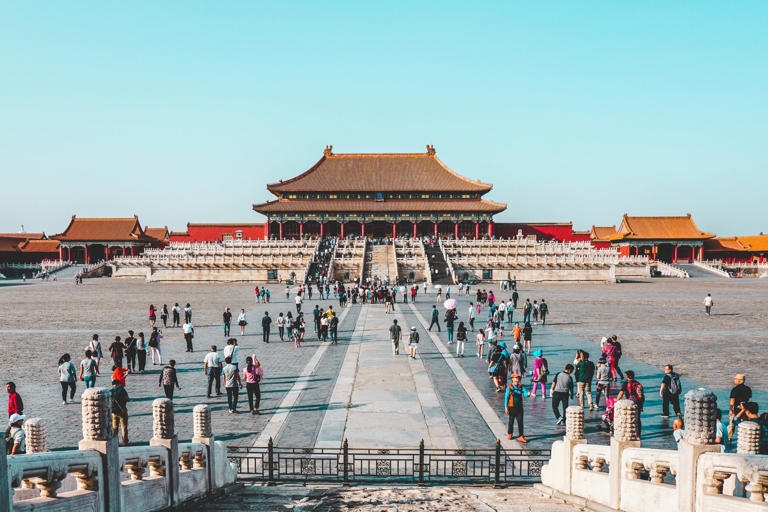

IMAGES
VIDEO
COMMENTS
Beijing, the capital city, possesses about 573km (356 miles) of the Great Wall including the world famous Badaling, Mutianyu, Jiankou, etc., stretching alone the steep peaks and hills at its remote northern districts. You can easily plan a satisfied day trip to the closer sections of the Great Wall from Beijing.
Though the Great Wall is over 6,000 kilometers long, the best 10 sections to visit are around Beijing's north and east: 1) the best-restored, Mutianyu, 2) the most beautiful, Jinshanling, 3) the wildest, Jiankou, 4) Simatai, 5) Huanghuacheng, 6) Gubeikou, 7) Juyongguan, 8) Huangyaguan, 9) Shanhaiguan, and by far the most crowded 10) Badaling ...
A Complete Guide to Visiting the Great Wall of China. The Great Wall of China stretches 13,000 miles over mountains, forests, reservoirs, and desert. It took a millennium to build, involved multiple dynasties, and pissed off a lot of Huns. Inextricably tied to the history of the country, to visit China without seeing it would cause you to be ...
As China's most famous attraction, the Great Wall of China is an essential stop on all China tours. Commonly considered a wonder of the world, the Great Wall boasts a history of over 2,000 years and stretches more than 3,000 miles across several provinces of northern China, making it one of the most impressive ancient structures on the planet.
The Great Wall of China, the largest man-made project in the world, is a series of ancient fortifications built in northern China. ... it is certainly the No. 1 iconic attraction in China. There are wall remains found in 15 provinces of China. The well-preserved sections we see today were mainly built during the Ming Dynasty (1368 - 1644 ...
Every year, more than 10 million people flock to the Great Wall of China, making it one of the world's most popular tourist attractions. The Badaling section sees the most visitors each year. It ...
To get the most from the Great Wall, a must-visit China attraction, you should follow the advice to plan a perfect Great Wall trip: 1. Choose the Best Times to Visit. 2. Select the MOST Suitable Section to Visit. 3.
6 Things to Do on Mutianyu Great Wall of China. - Last updated on Jan. 03, 2024 by Brenda Lian -. 6 best places to see Great Wall of China are Mutianyu, Badaling, Simatai, Jinshanling and Jiankou in Beijing; and Gansu for Jiayuguan, Yumenguan and Dunhuang Great Wall.
The building methods of the Great Wall in different times and places have been integrally maintained, while the unparalleled national and cultural significance of the Great Wall to China is still recognised today. The visual integrity of the Wall at Badaling has been impacted negatively by construction of tourist facilities and a cable car.
And he was right—the Great Wall of China is undoubtedly one of the ancient world's most amazing feats of engineering. To the Chinese, the Great Wall is known as "Wan Li Chang Cheng" (万里长), or literally, "Long Wall of Ten Thousand Li" ("li" is a measure of distance about 500m or about a third of a mile). But of course, that ...
4. Jiankou [SEE MAP] Located some 70 kilometers to the north of Beijing, Jiankou is the wildest, most dangerous, and therefore most exhilarating part of the Great Wall to explore. Completed all the way back in 1368, the wall hasn't been restored since.
A recent government mapping project revealed that the entire Great Wall structure spans some 5,500 miles (8,850 kilometers) from the Korean border west into the Gobi desert. Of that total 3,889 ...
Some of the best tourist attractions along the Great Wall of China include Badaling Great Wall, Shanhai Pass, Baishi Mountain, and Yanmen Pass Scenic Area. Other AAAAA-rated tourist attractions in China include Mount Pan in Tianjin, Guwenhua Jie in Tianjin, Olympic Green in Beijing, and Baiyang Lake in Hebei among others. 4.
The best-known section of the Great Wall of China—Badaling, located 43 miles (70 km) northwest of Beijing—was rebuilt in the late 1950s, and attracts thousands of national and foreign tourists ...
Picnic on the Great Wall. 4. Take a Toboggan Down from the Wall. 5. Outstanding Helicopter Experience. 6. The Huangyaguan Great Wall Marathon. 1. Walk on the Great Wall at Night - Coolest Thing Ever.
Reason 1: The Great Wall is China's No. 1 Tourist Site. The Great Wall of China is the hottest attraction in China. A tour to China without Great Wall is not complete. The Great Wall - No.1 Attraction of China.
The length of the Great Wall of China is 21,196.18 km (13,170.7 mi), half the equator!. The data came from the State Administration of Cultural Heritage. In 2009, the State Administration of Cultural Heritage first published data on the Ming Dynasty Great Wall, which measured 8,851 kilometers (5499 miles). See more on How Long Is the Great Wall ...
The Great Wall of China (traditional Chinese: 萬里長城; simplified Chinese: 万里长城; pinyin: Wànlǐ Chángchéng, literally "ten thousand li long wall") is a series of fortifications that were built across the historical northern borders of ancient Chinese states and Imperial China as protection against various nomadic groups from the Eurasian Steppe.
The Great Wall holds immense historical and cultural significance, representing the resilience, unity, and ingenuity of the Chinese civilization. As a major tourist attraction, the Great Wall offers visitors a unique opportunity to immerse themselves in the rich tapestry of Chinese history and culture. Its historical significance, architectural ...
The Great Wall was important in defending China from northern invasion for centuries, and has become a national symbol, and China's top tourist sight. ... Popular Tourist Attraction. The Great Wall is famous all over the world and attracts 4 million tourists every year. It attracts tourists for its historical and archeological value, as well ...
There's also a guided tour option to the Jinshaling section that includes transportation and a guided hike from Beijing. This part of the wall is 3.4 miles in length and it has been renovated, so it's safe to climb. You can enter at two points - the north and the south. Both require quite a bit of hiking.
"As China's most famous attraction, the Great Wall of China is an essential stop on any trip to China," The China Guide wrote. "Commonly considered a wonder of the world, the Great Wall ...
The new limit is a long overdue response to a national guideline issued in 2015, which suggests the optimal capacity for a variety of China's tourism sites. The Badaling Great Wall, for example ...
China is the third most visited country globally, with a rich tapestry of attractions beyond the famous Great Wall. From ancient relics in Xi'an to the bustling streets of Shanghai, there's ...